70 Years of Height Evolution in the NBA [4,504 players analysed]
“You can’t teach height” - Red Auerbach
We spent 2 months analysing 24,841 records of 4,504 NBA players during 69 NBA seasons in order to show how the game of basketball evolved through the evolution of players’ height.
Special note to Kirk Goldsberry, whose book “Sprawlball” inspired the creation of this research. This article is a height spinoff of “Sprawlball”.
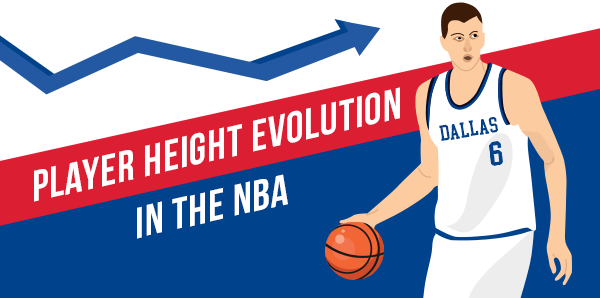
Key findings:
- The average NBA player is 6'6.3'' tall and has never been shorter over the past 39 seasons.
- Point guards are the tallest they’ve ever been in league history. All other positions are the shortest since the 80s.
- 72% of the league is under 6’9’’ tall (most over the past 40 seasons)
- 40% of the power forwards’ FG attempts are 3-pointers (first time in NBA history). Centres are getting close to 20% (19.5).
- While declining in number, NBA’s big-men are dominating in shooting efficiency and PER, breaking all-time NBA records.
- International big-men are one of the most valuable assets for NBA teams - 53% of the NBA’s 7-footers are international players, and 46% of NBA centres are from overseas.
1. Height and weight throughout NBA history
The average NBA height is 6’6.3’’ (2021), which is the lowest over the past 41 years. The last decade was the first in the history of the league where NBA players got shorter than a decade before.
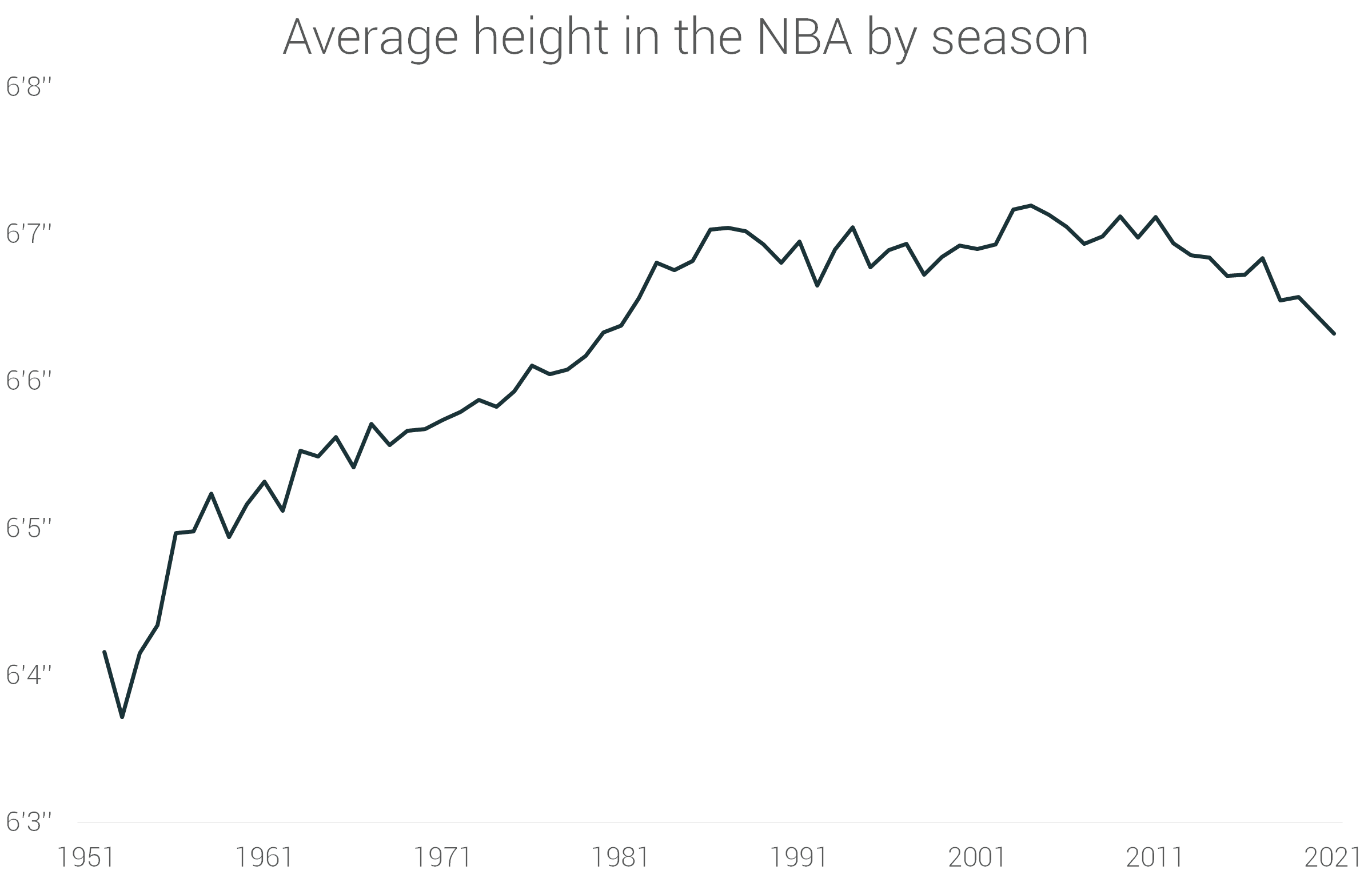
NBA point guards are 6’2.4’’ tall, tallest they’ve ever been.
All other positions (shooting guards, small forwards, power forwards, and centres) are the shortest since the early 80s.
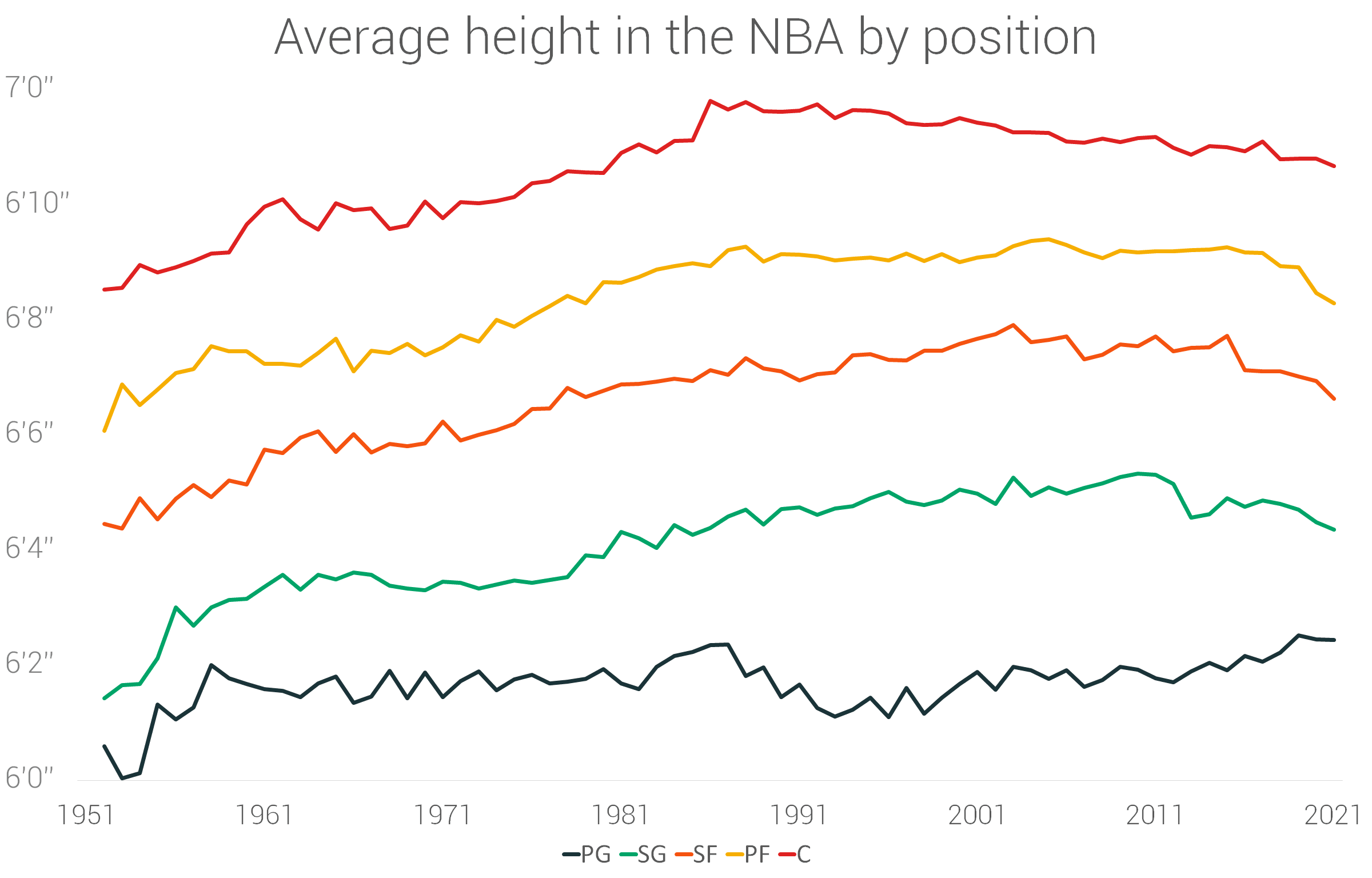
The average weight in the NBA was growing since the 70s, peaked in the 2010/11 season, and has been declining ever since.
NBA players are the lightest they’ve been in the 21st century. The average weight of an NBA player is 217 lbs (2021).

Similar to height evolution, point guards are the heaviest they’ve ever been. All other positions are getting lighter.
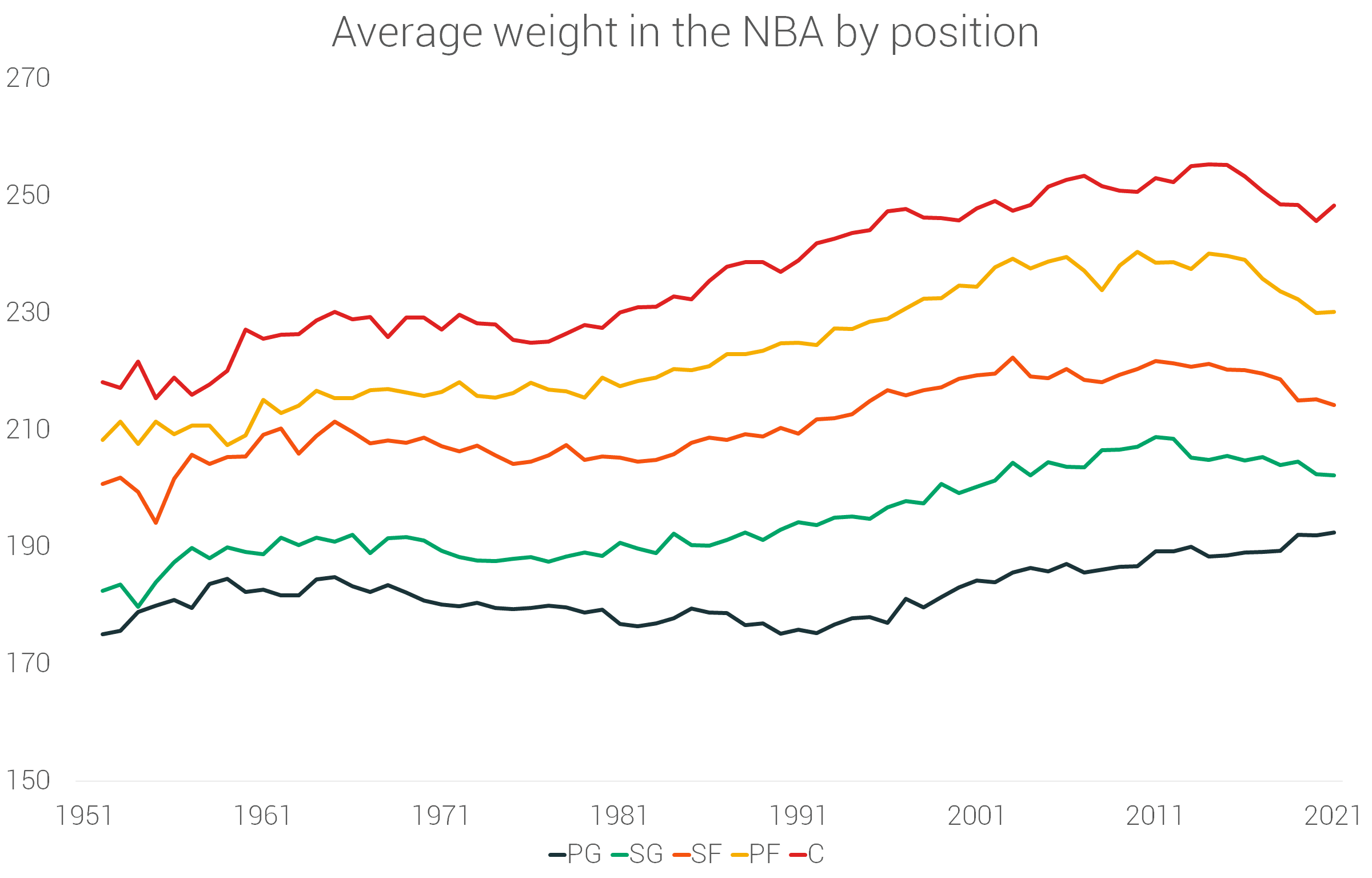
BMI of NBA players is declining over the last few seasons. The average BMI of NBA players is 24.77 (2021).

It’s understandable that NBA players, especially big-men, had to become more agile and lighter in order to adapt to the perimeter-oriented game. This is why NBA centres and power forwards are facing the biggest drop in their BMI.
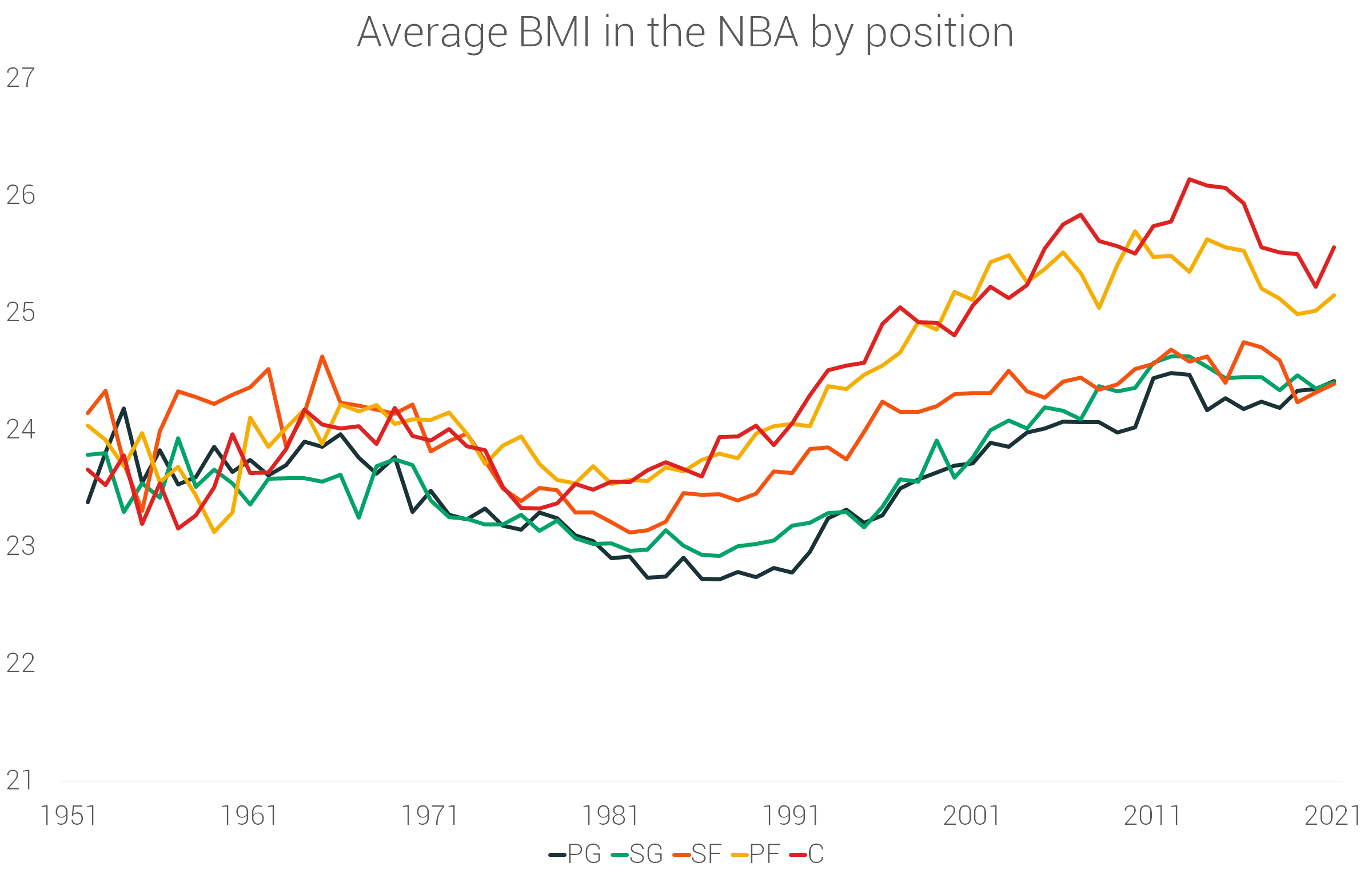
As a consequence, today we have the smallest share of “overweight” players in the NBA (BMI>25) over the past 15 years. Only 43% of NBA players are overweight according to their BMI.
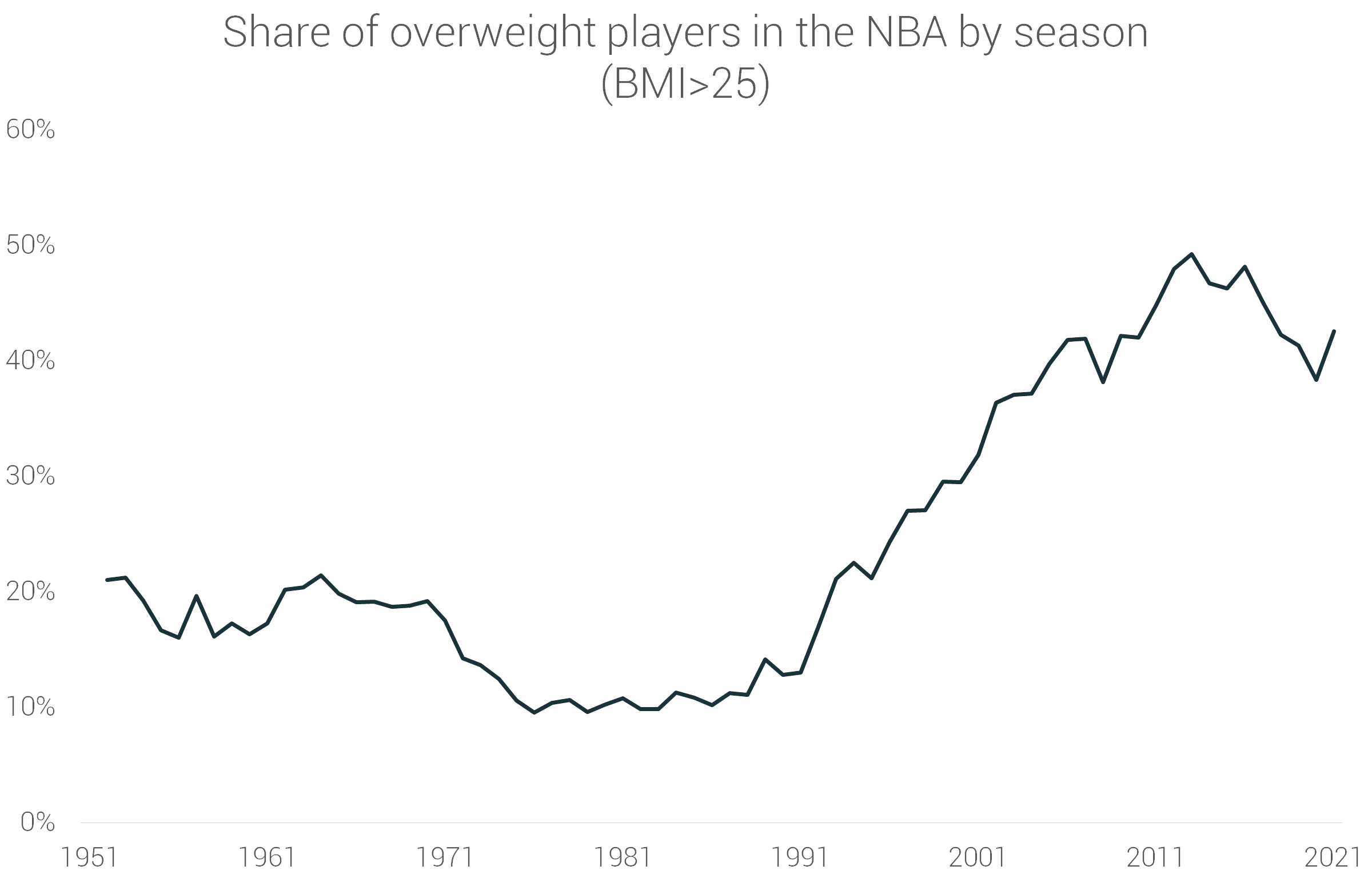
The ideal concept of the small-ball game is having 5 guys with the same physical attributes and skillset - this is positionless basketball at its peak.
So it’s not strange that 61.5% of the NBA players are within 6 inches, standing between 6’3’’ and 6’9’’ (2021). All other height ranges are in decline.
Also, 73.7% of the league is under 6’9’’.
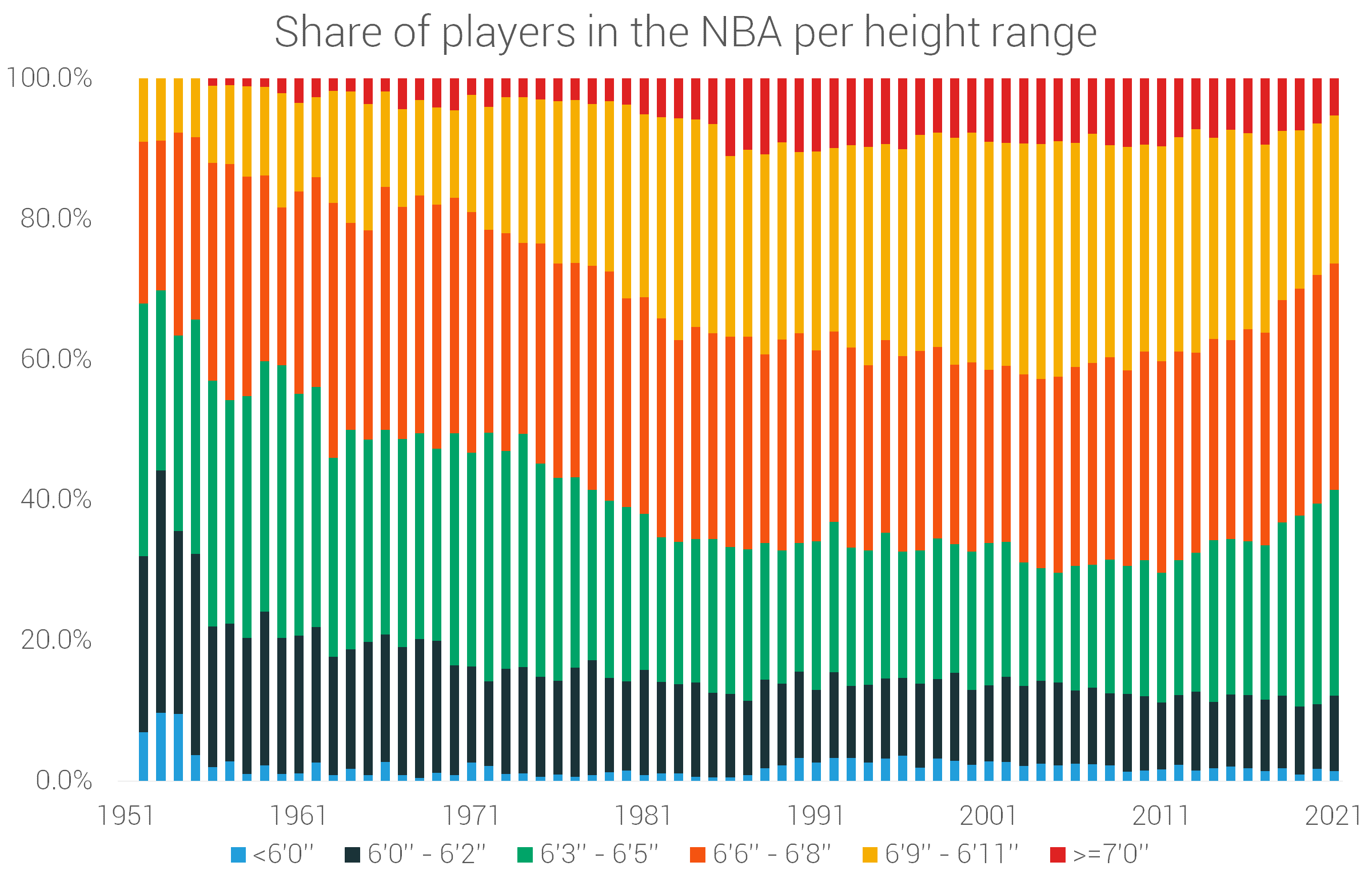
2. Shooting evolution through height
Ever since the 60s, players shorter than the league average have been attempting more field goals than taller players. However, in 2021, there is an equalisation of average height and height weighted by FGA.

On the other hand, over the last couple of decades players taller than league average proved to be more accurate shooters, which can be seen by weighting height by FG%.
Today, the difference between height weighted by FG% and the average NBA height is the biggest in NBA history:
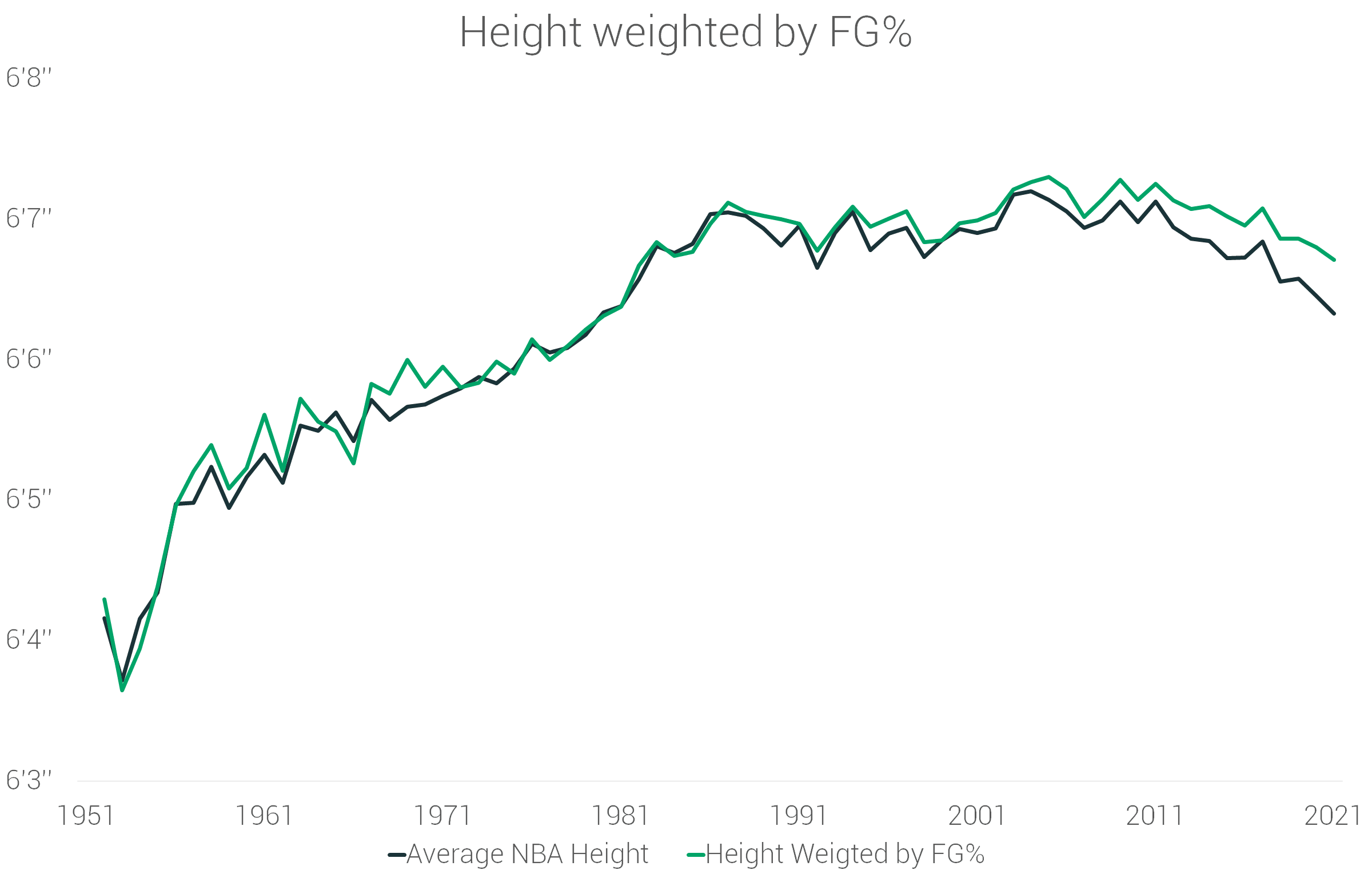
NBA centres are the only players who still spend some time inside the 3-point line. As a consequence, NBA centres have the highest FG% that anyone ever had in the history of the league.
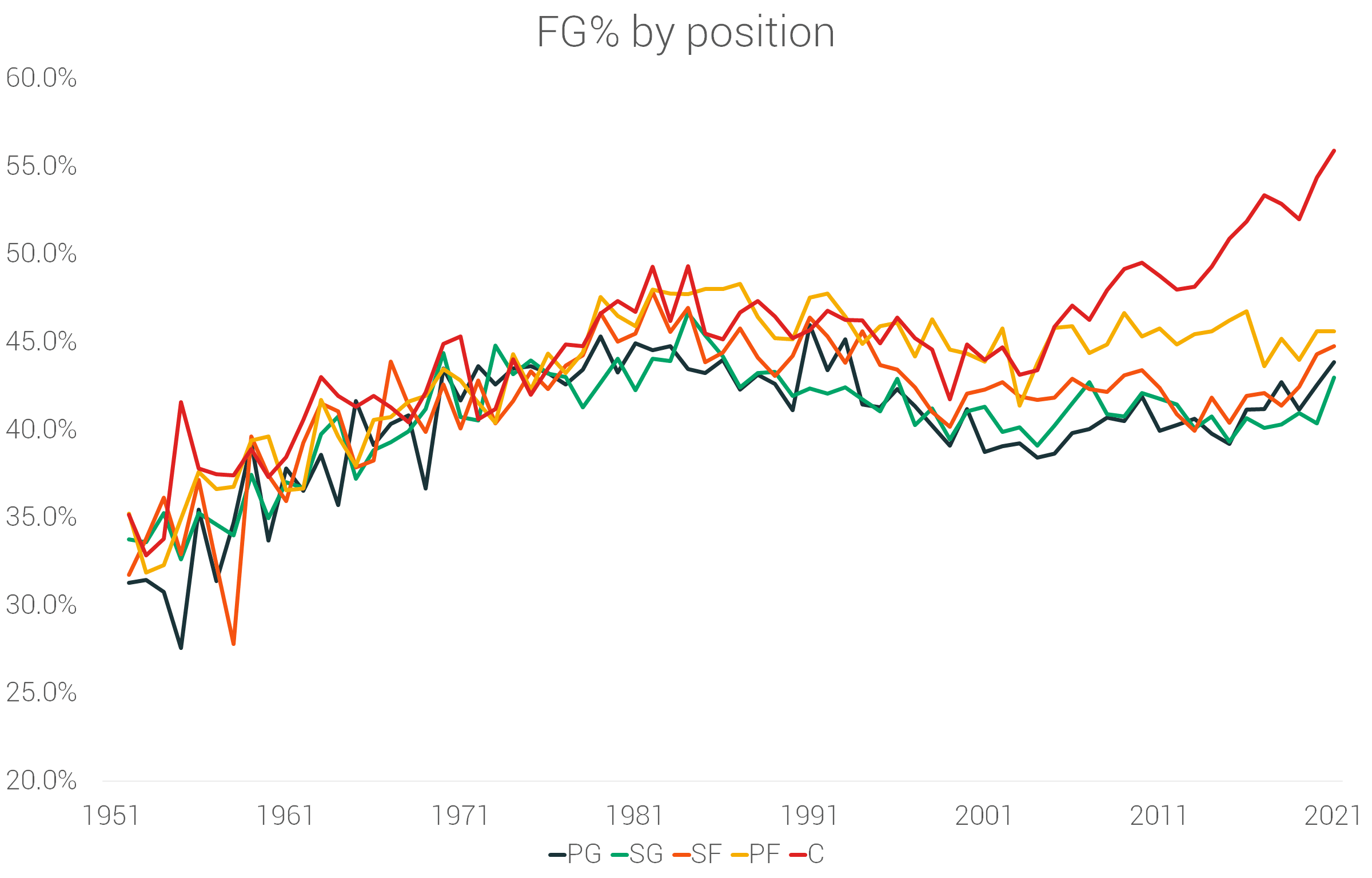
Players taller than 6’9’’ have constantly been increasing their shooting efficiency over the past 20 years. They are the only group that makes more than 50% of their field goal attempts. All other groups are below 45%.
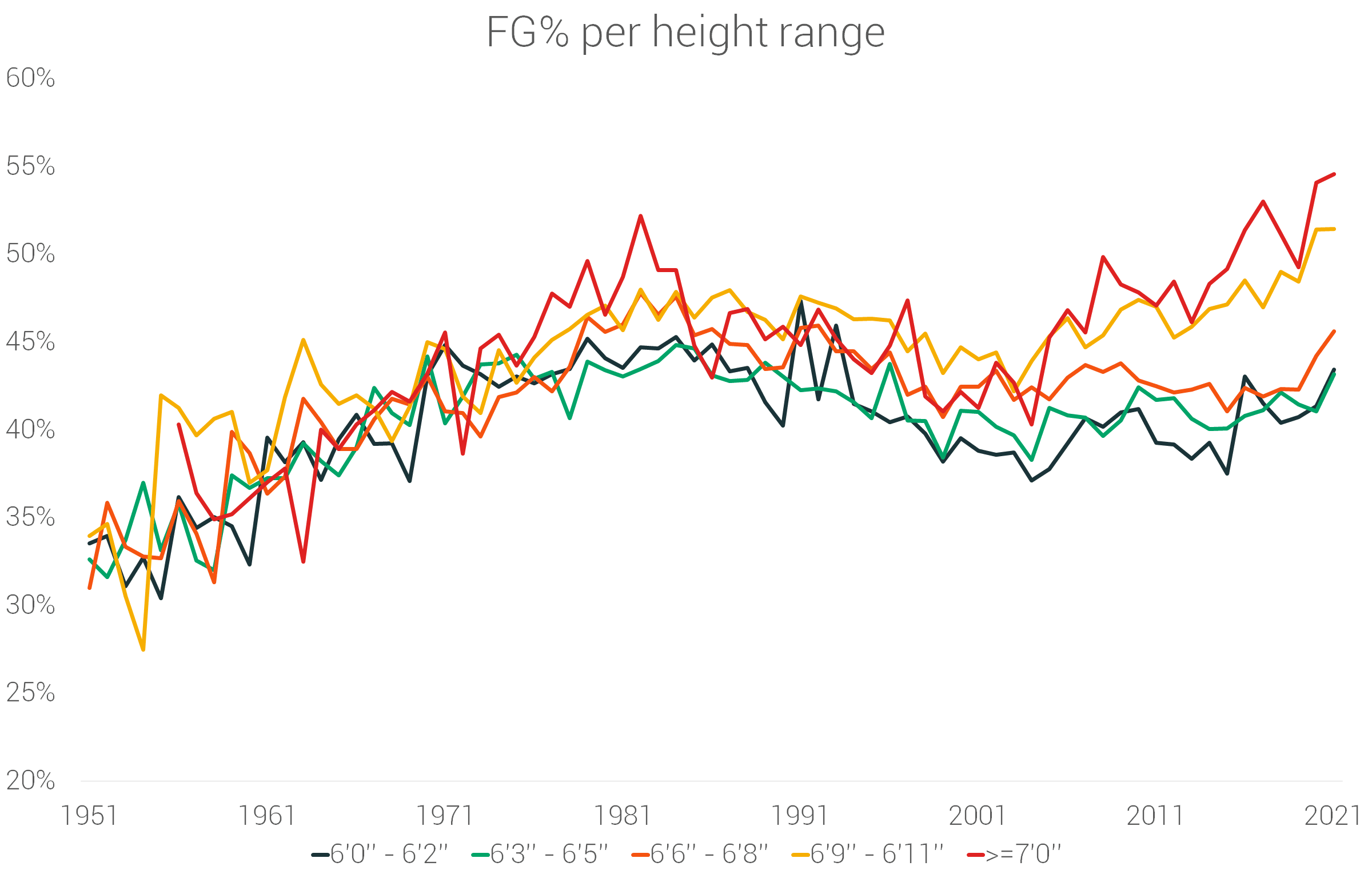
For the first time in NBA history, players from one position have a TS% above 60% - NBA centres. And for the 5th season in a row, all positions are above 50%.
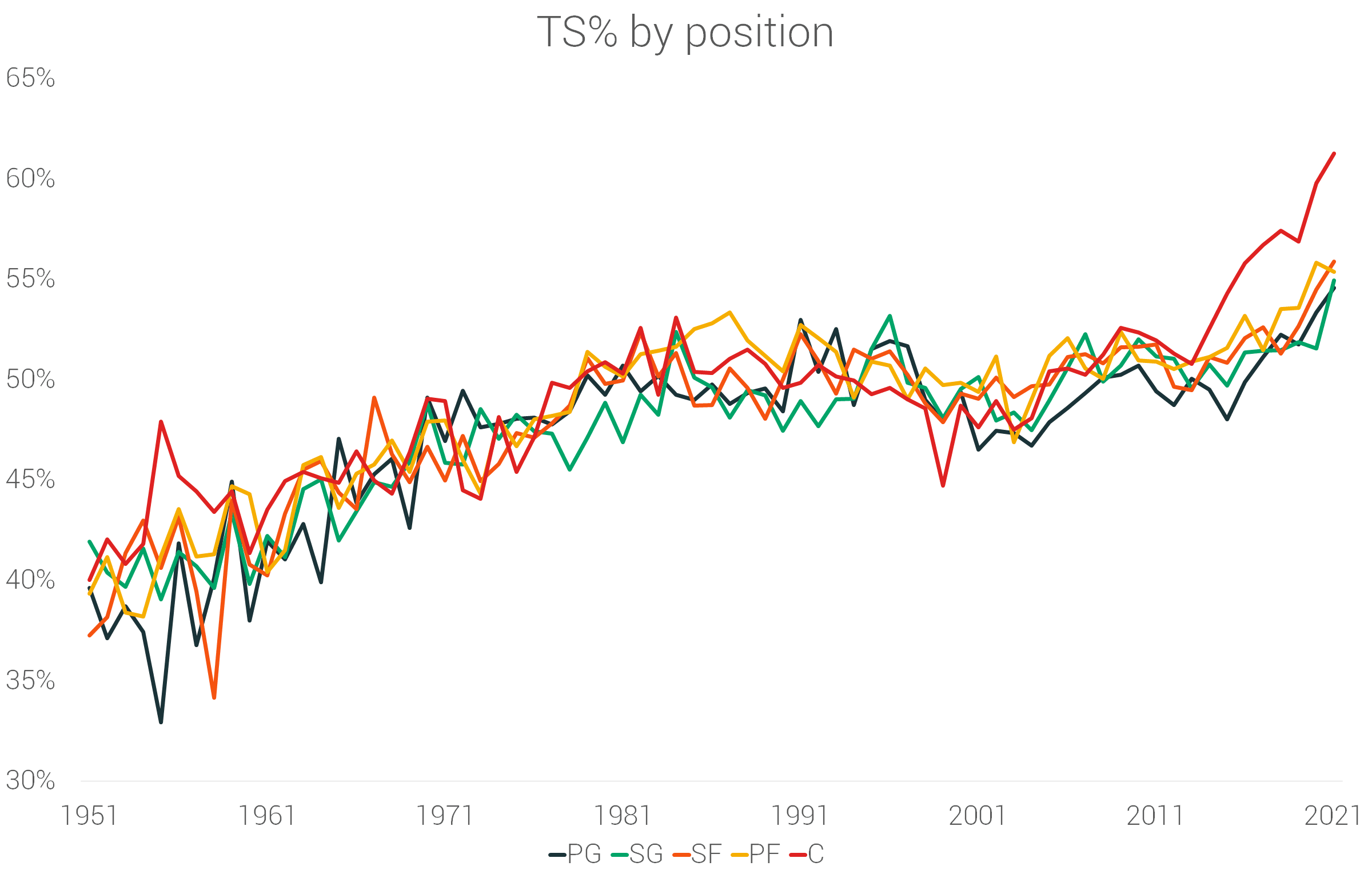
2019/20 season is the first in NBA history where all height ranges TS% average goes over 50%. 7-footers are the first group at the 60%-mark.
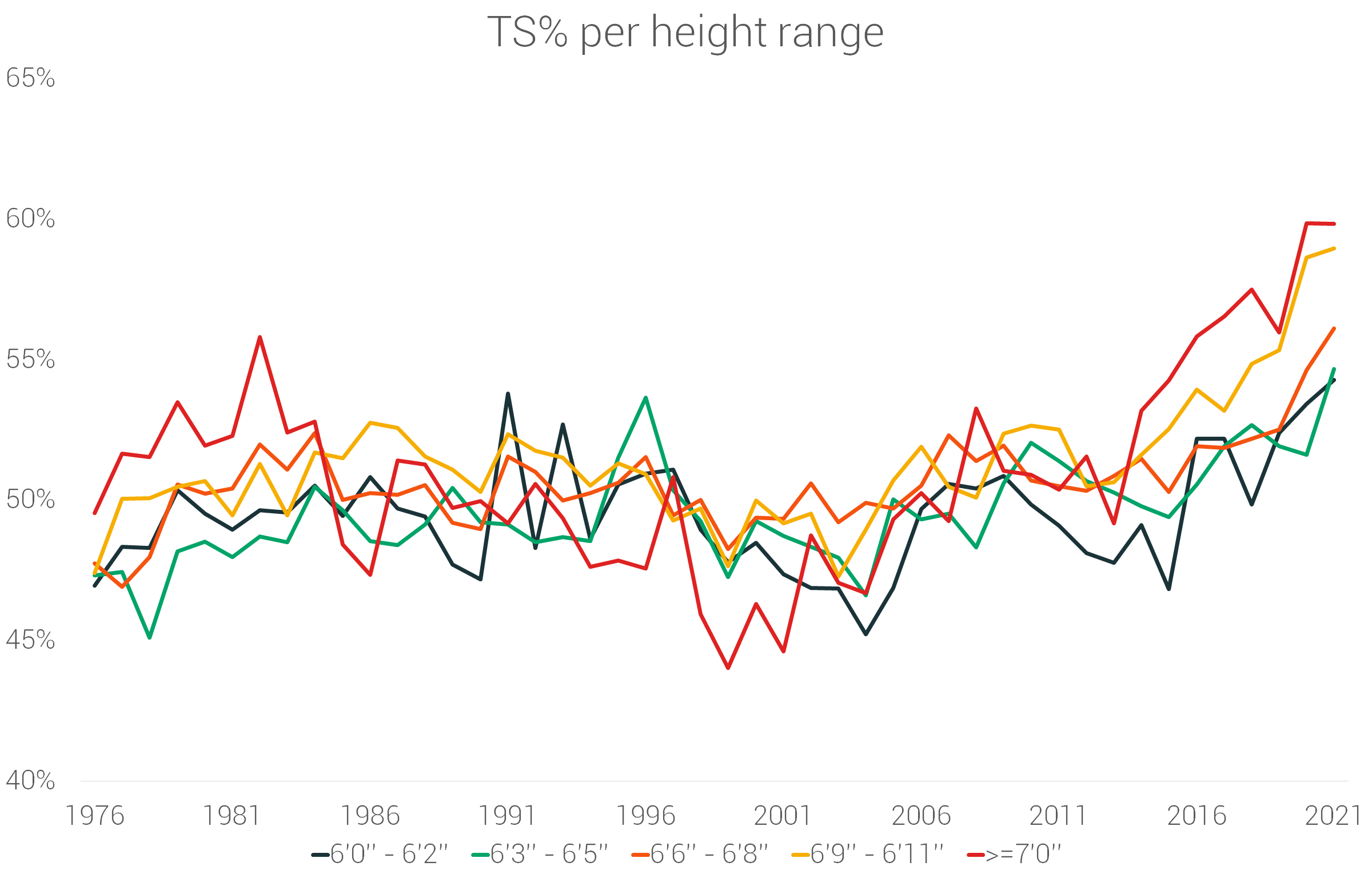
As NBA big-men started to take more and more 3-pointers, height weighted by 3PA is closest to average NBA height since the introduction of the 3-points line.
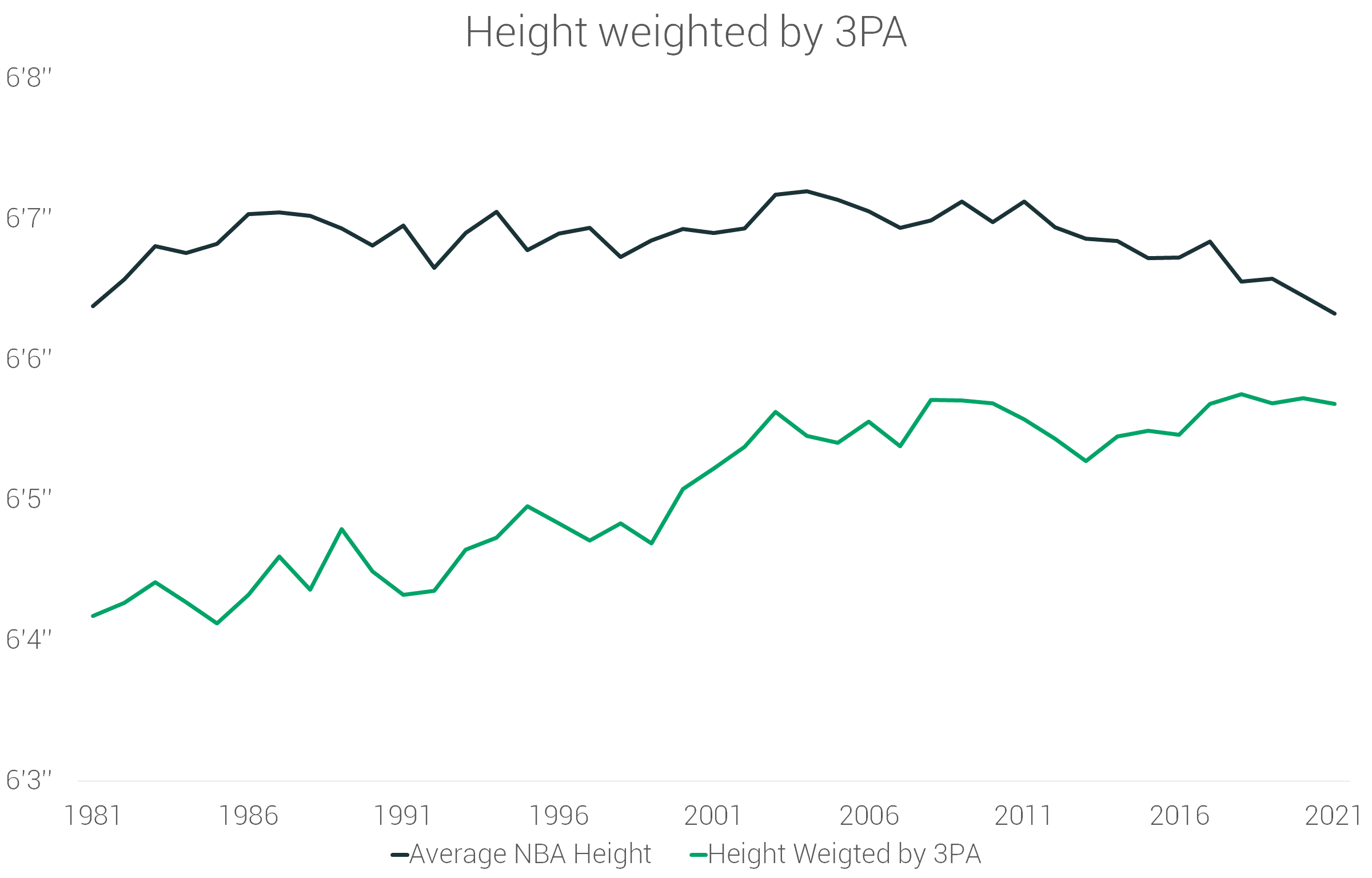
While the whole league volumes up 3-point shooting, it’s the NBA big-men who faced the most radical transformation. Over the last decade, power forwards and centres increased the number of 3PA by 167% and 323%, respectively.

The average 7-footer in the NBA attempts 85 3-pointers in a season. This is a 231% increase over 10 years, and a 147% increase in 5 years only.

It's the same story with the share of 3-point shots in the total FGA, indicating that taller players increasingly exchange 2-pointers with 3-pointers.
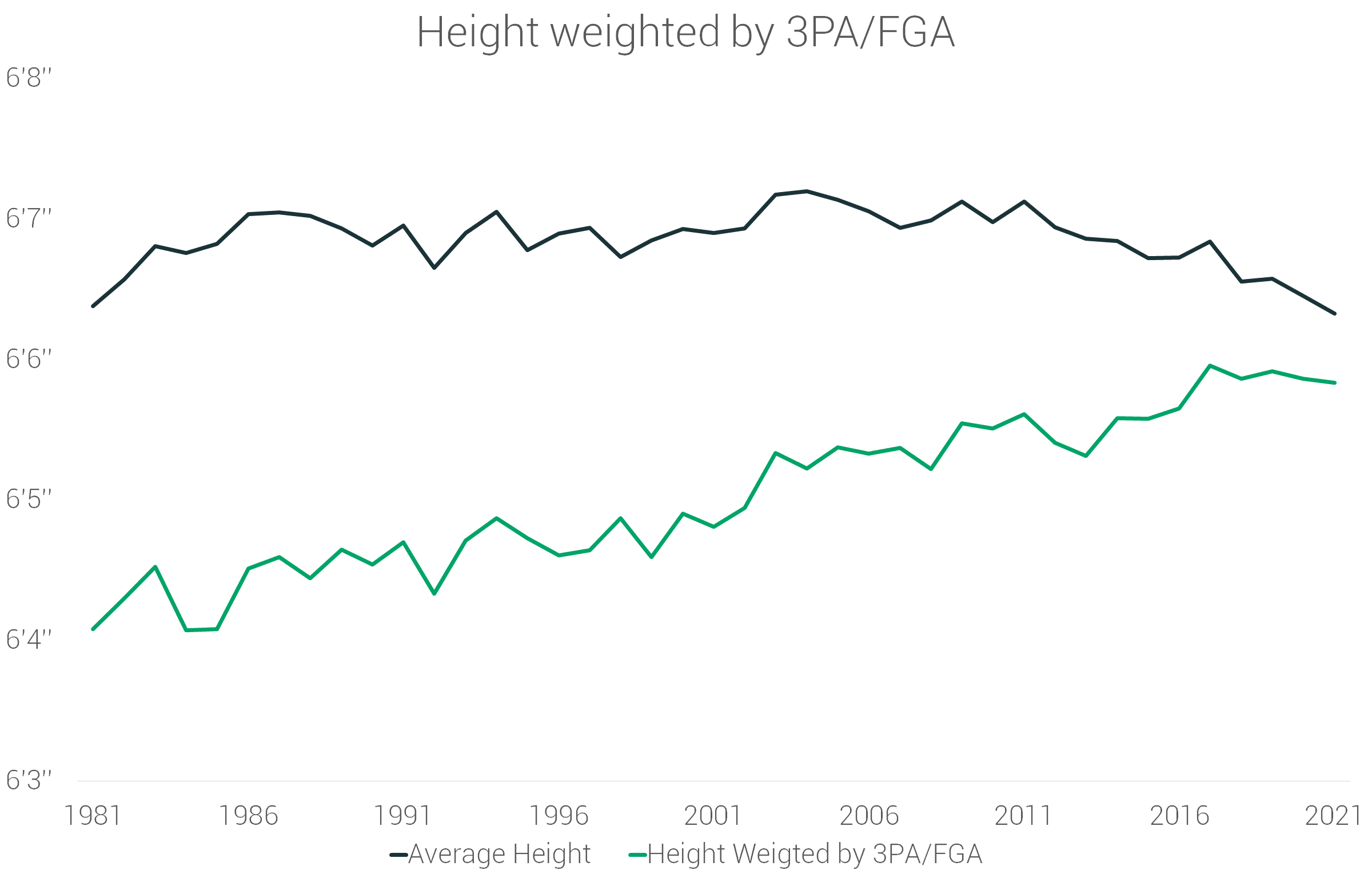
40% of NBA power forwards field goal attempts is beyond the 3-point line, 2.45 times more than in the 2009-10 season, and 124% more than in the 2014-15 season. During the same period, centres 3PA share jumped 5 times.

Even the NBA’s 7-footers are taking at least 20% of their field goal attempts beyond the 3-point line. Players shorter than 6’9’’ are getting close to the 50% mark.

3. Game evolution through height
The evolution of the game reflects on the rebounding patterns. Looking at the offensive boards, it’s noticeable that the offensive rebounding is on the decline.
NBA centres are the only player who somewhat maintained the rebounding rate from the last decade. Power forwards, who moved out of the paint, dropped their offensive rebounds average by 45% in 10 years, and are closer to guards than ever before.
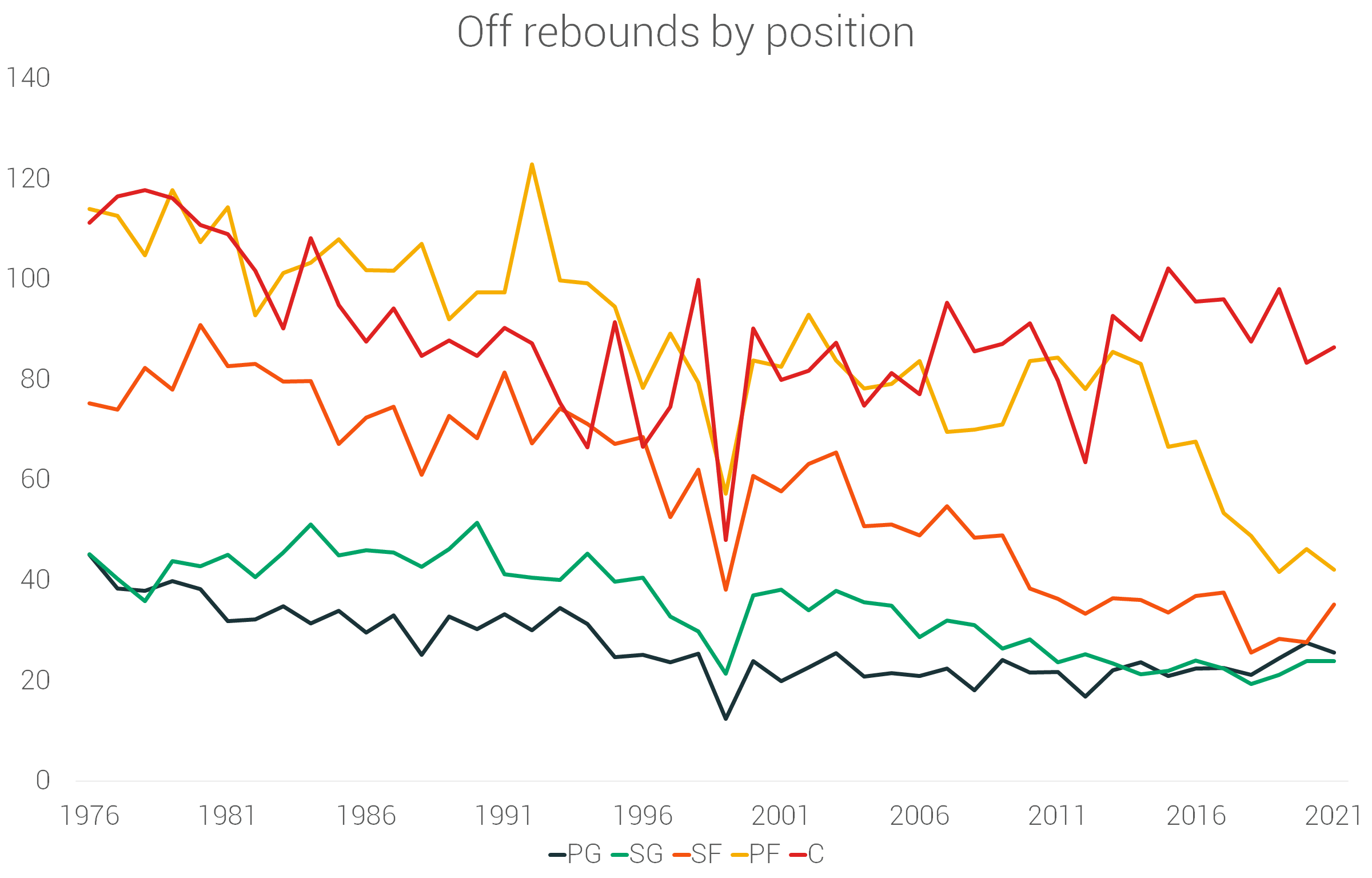
It’s not a surprise that only NBA 7-footers increased off rebounding over the past 10 years, while all shorter players are facing decline:
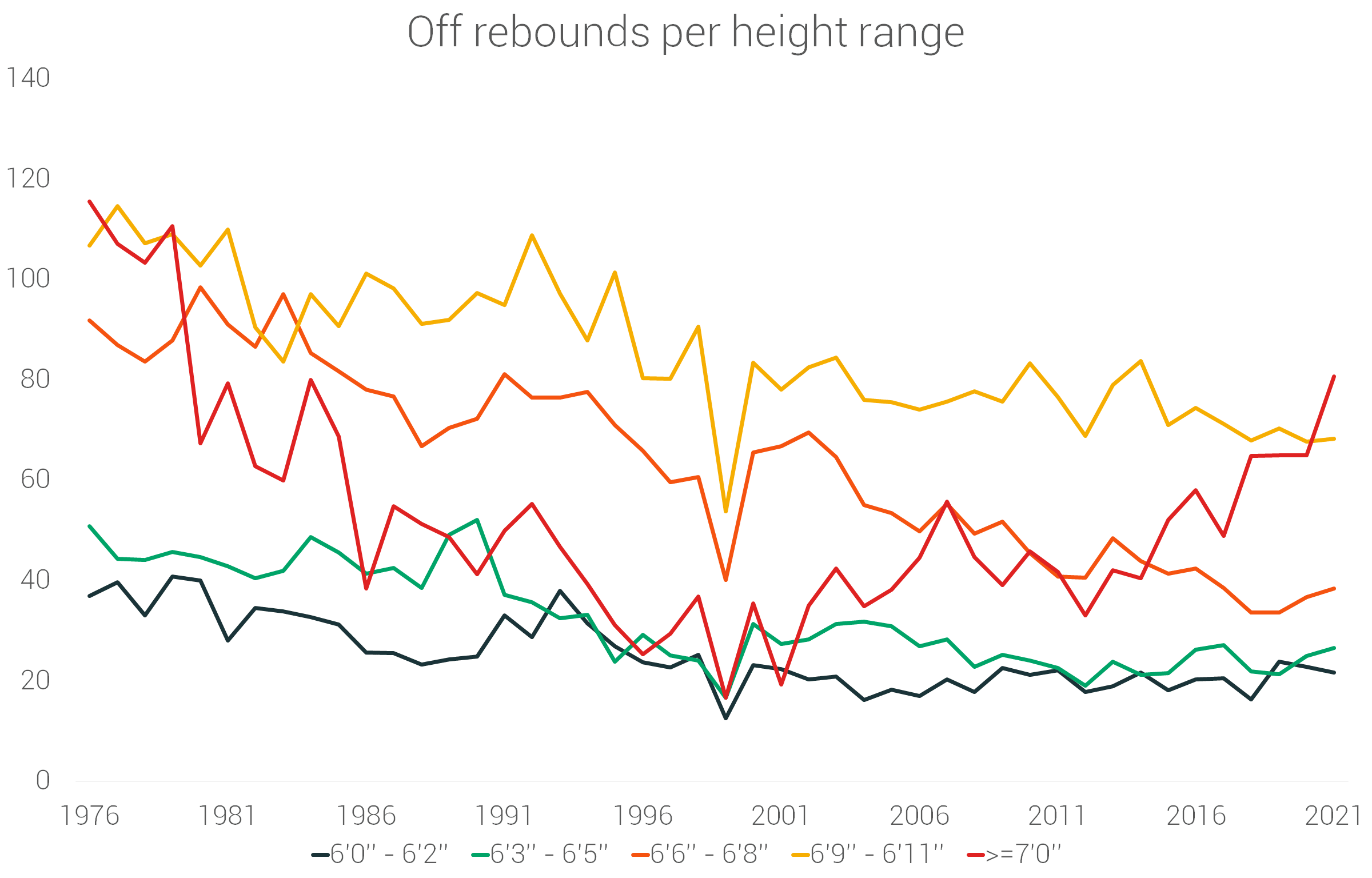
It’s a similar story with defensive rebounds, where things have been more stagnant over the last 30 years. This is understandable as defensive rebounding requires more team effort and cooperation.
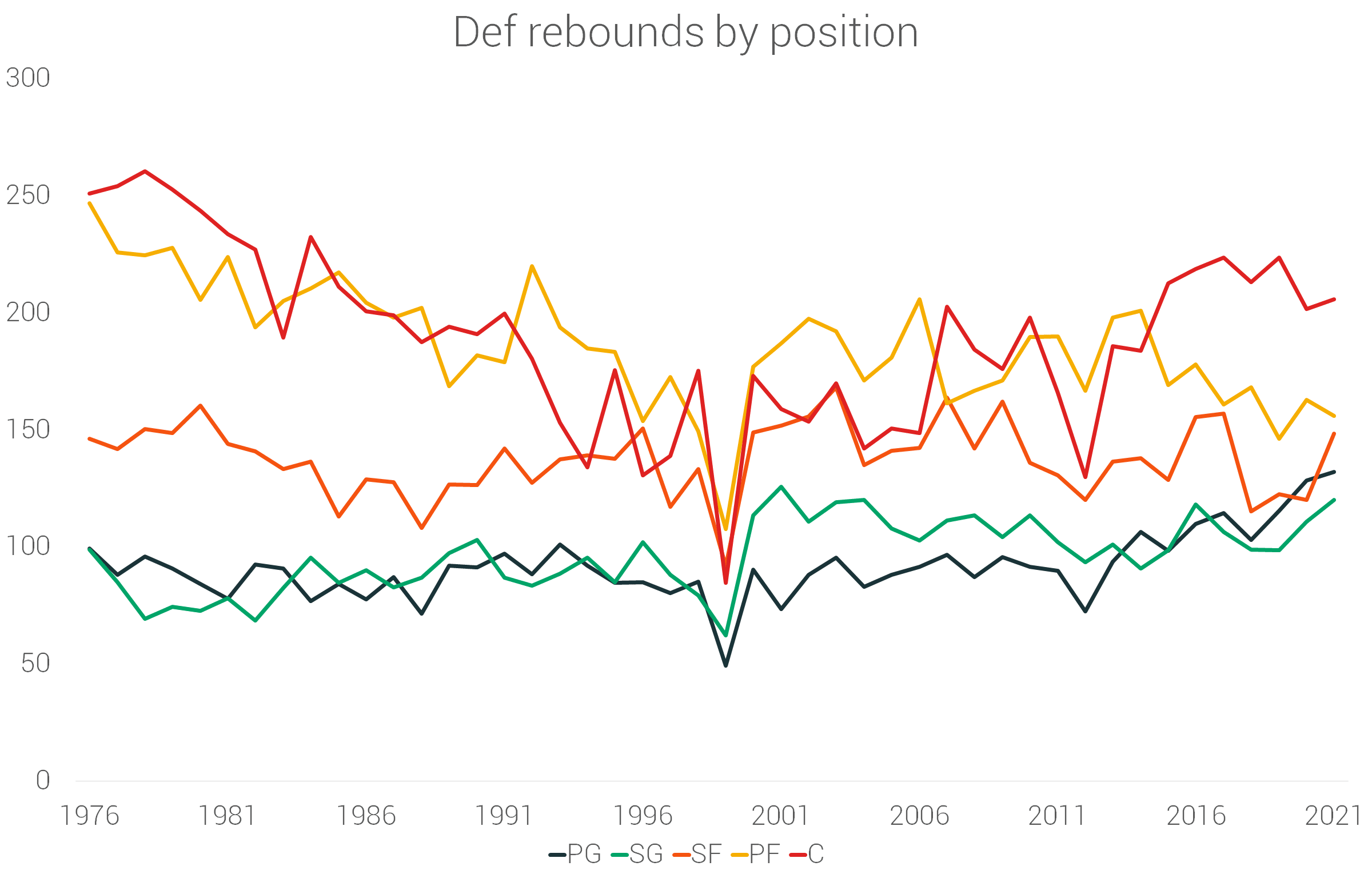
Especially in today’s game, where 4 or 5 guys on the court are playing beyond the arc, defensive rebounds are the most evenly distributed between positions since this stat has started recording.

Assist evolution through height tells another interesting story. The results show that taller players facilitate more than ever before, as height weighted by assists got closest to the average NBA height in the last 45 years.

Big-men are the only ones who are significantly increasing their assist rate - centres are assisting 29% more than 10 years ago, and power forwards increased assists by 23% during the same period.
Shooting guards and small forwards are actually assisting less than they did 10 years ago. For the first time in 40 years, NBA big-men assist as much as small forwards.
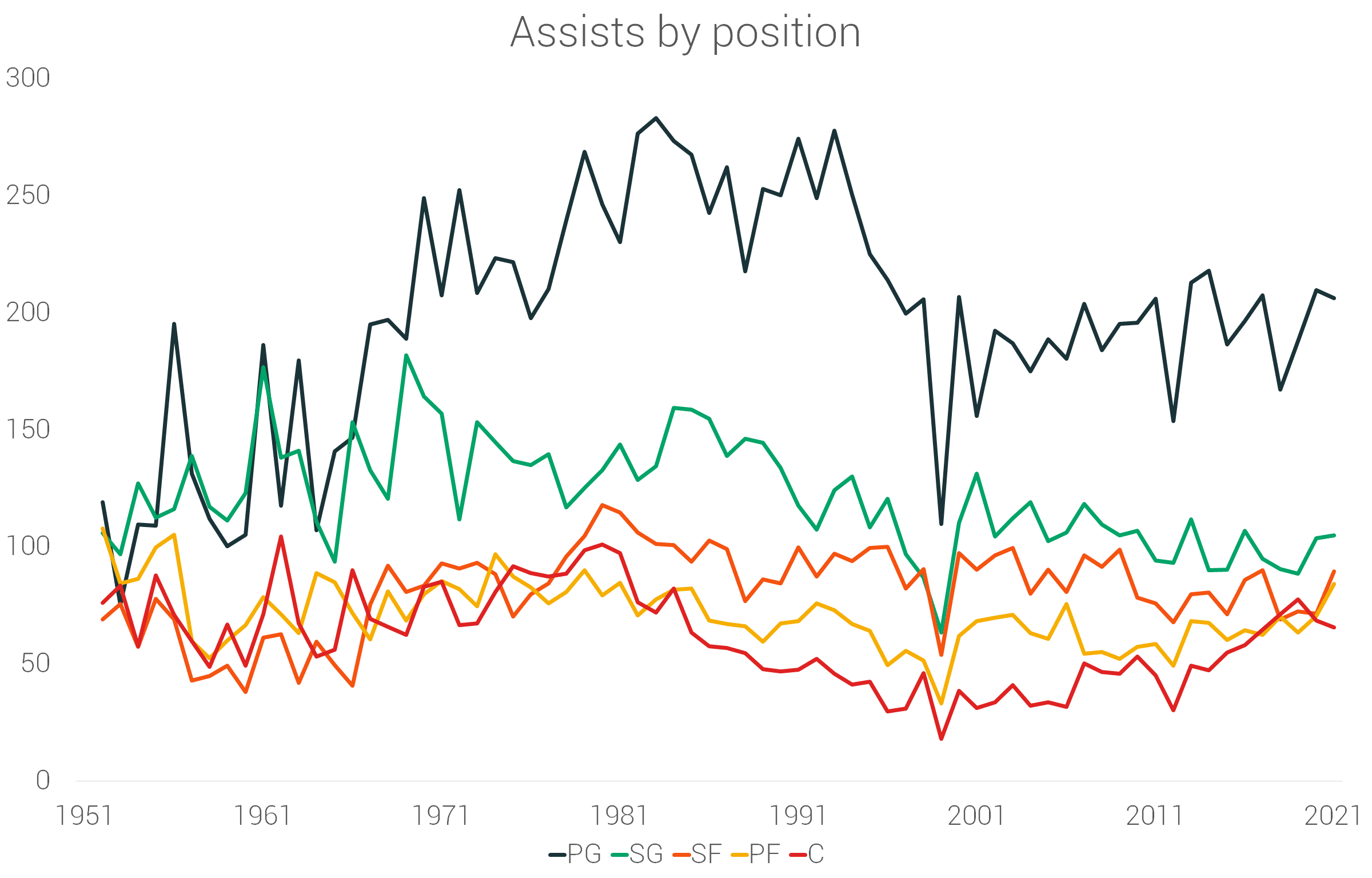
As a consequence, only players over 6’9’’ are increasing their assist averages.
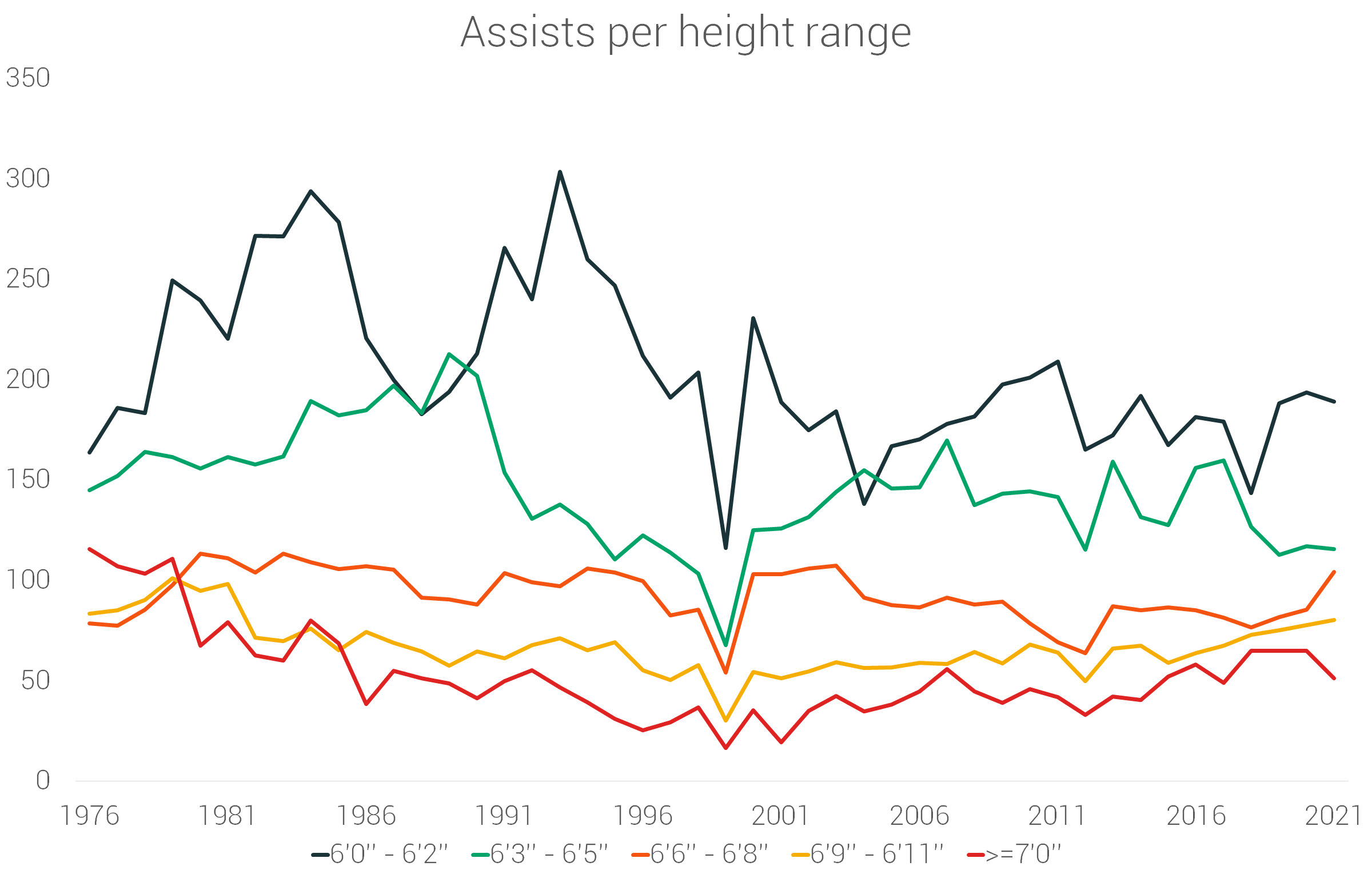
While NBA big-men are declining in number, they are dominating in efficiency. For the ninth season in a row, height weighted by PER is larger than average NBA height. This hasn’t happened since the 60s and the Russel-Chamberlain era.

NBA centres have the highest PER in the NBA for 7 seasons in a row. This has never happened over the past 60 years. It’s also interesting that the point guards average the highest PER ever.
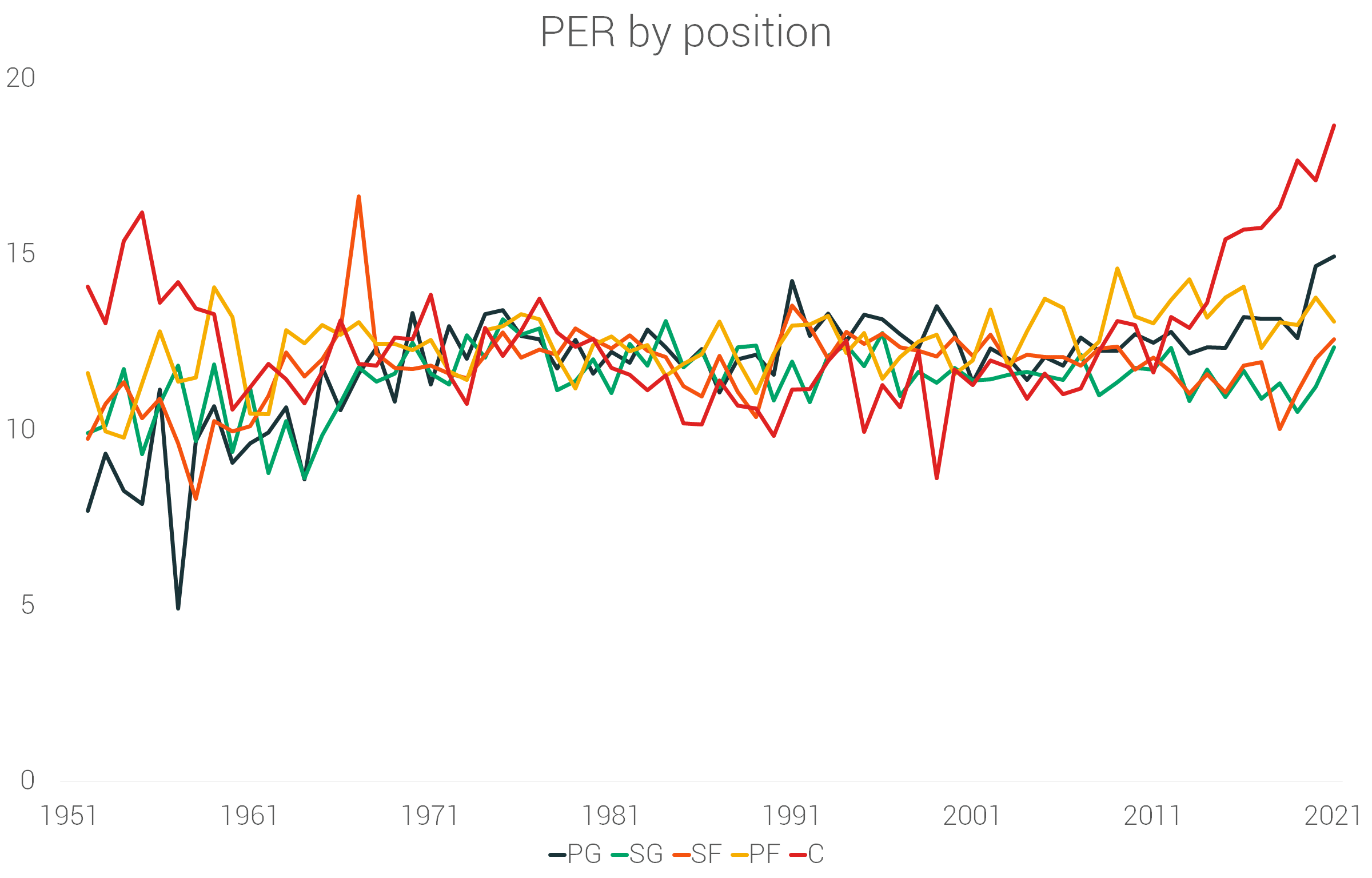
Players over 7-feet tall are averaging the highest PER in the history of the NBA (17,46), and are leading the league for 6 straight seasons (also the NBA record).
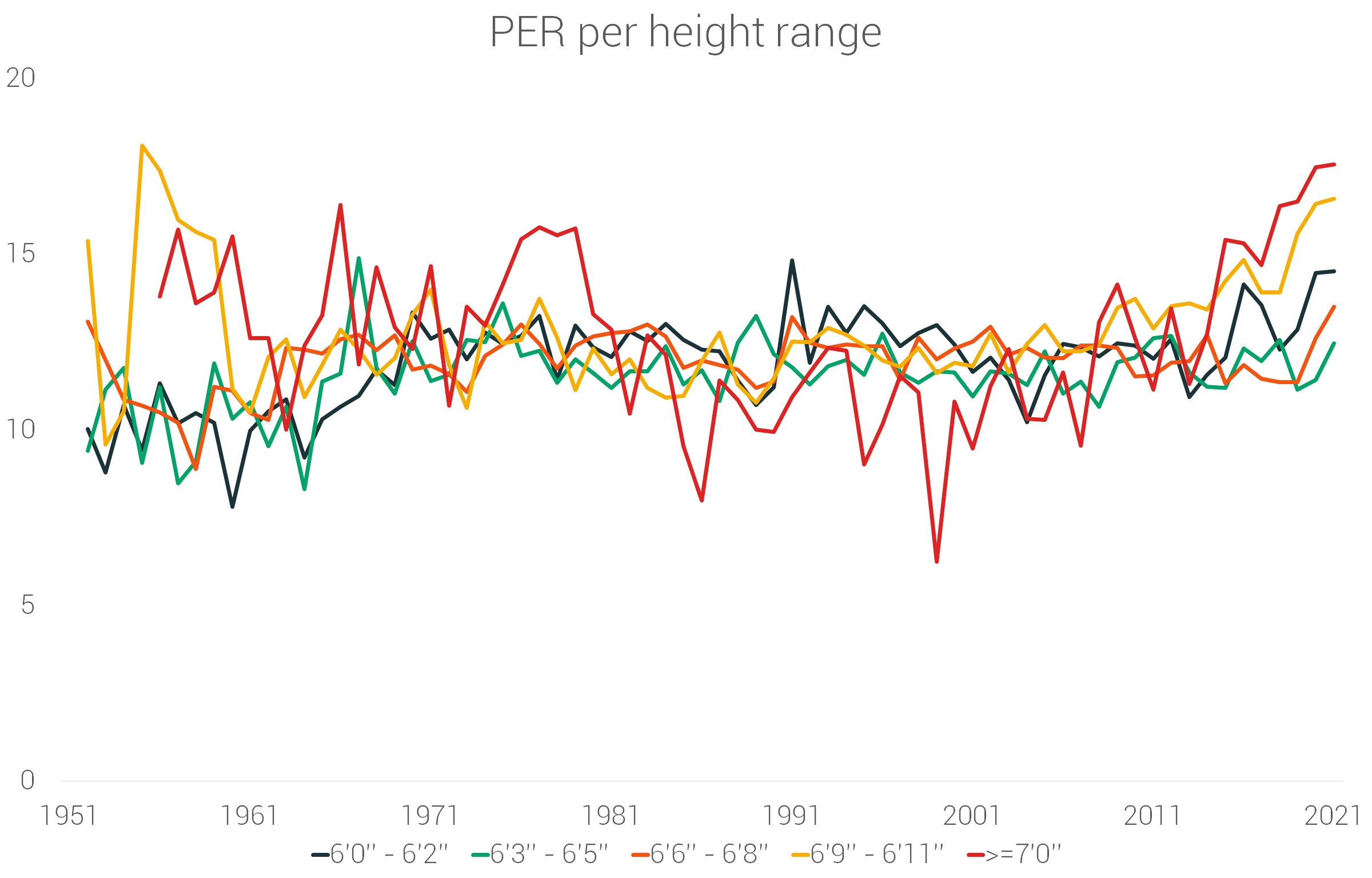
4. Rookie height evolution
Rookies’ data are an interesting tool to examine the league's year-to-year tendencies. The data are much more unstable and fluctuate more on a yearly basis, but they are more precise in explaining the league’s current trend.
The average height of NBA rookies is on a steady decline over the past several seasons. In 2021, NBA rookie was 6'5.8'' tall on average, the lowest since 2009.
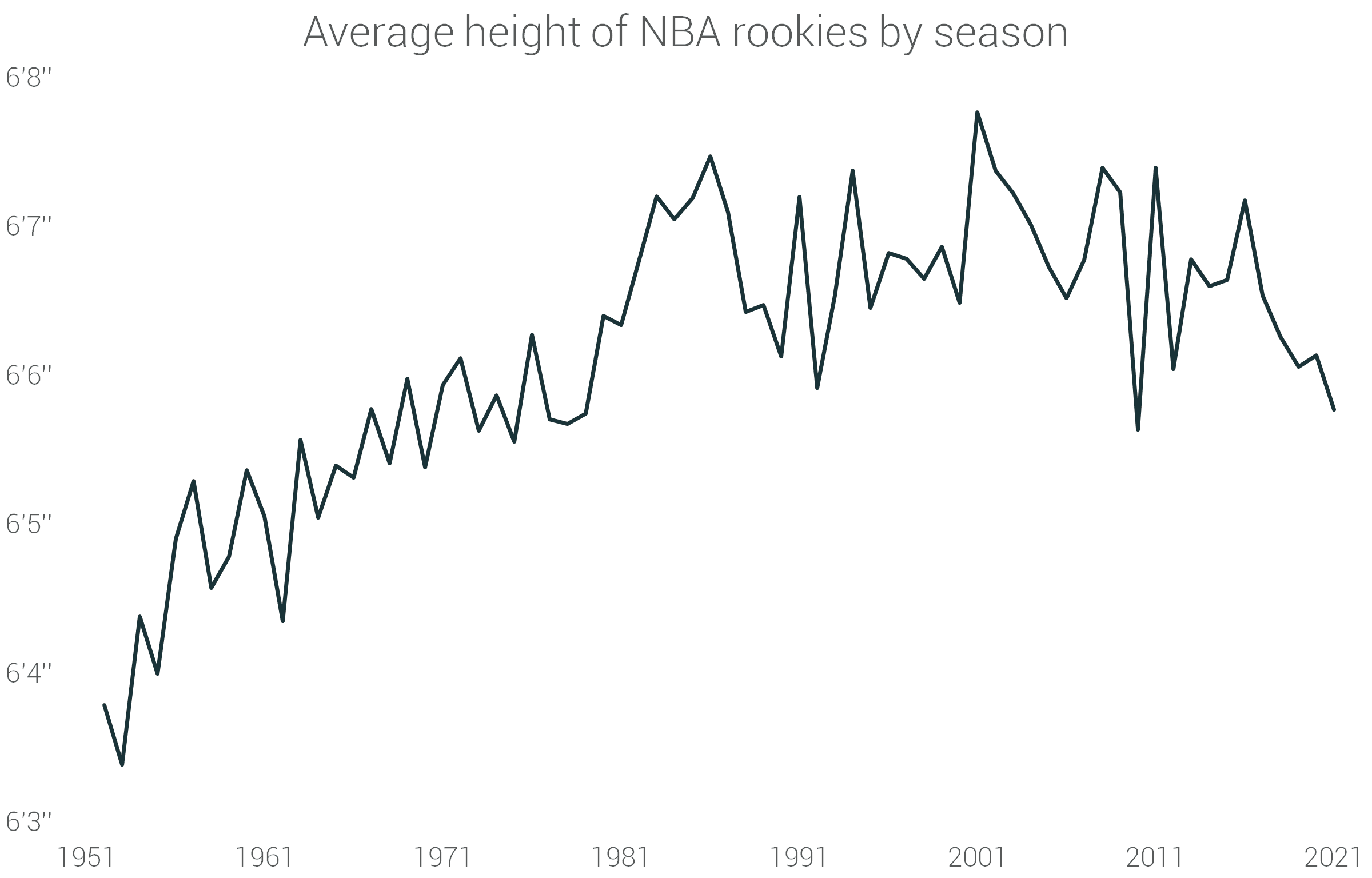
It’s noticeable that shooting guards and forwards are getting shorter over the past several seasons.

5. International players’ height evolution
Over the past 30 years, the NBA is increasingly opening up for overseas players. In the 2020-21 season, every 4th NBA player wasn’t American.
International NBA players today are 3% shorter than 20 years ago, and 0.7 inches shorter than 10 years ago. In 2021, the average height of international players was 6'8.1'', the lowest in league history.
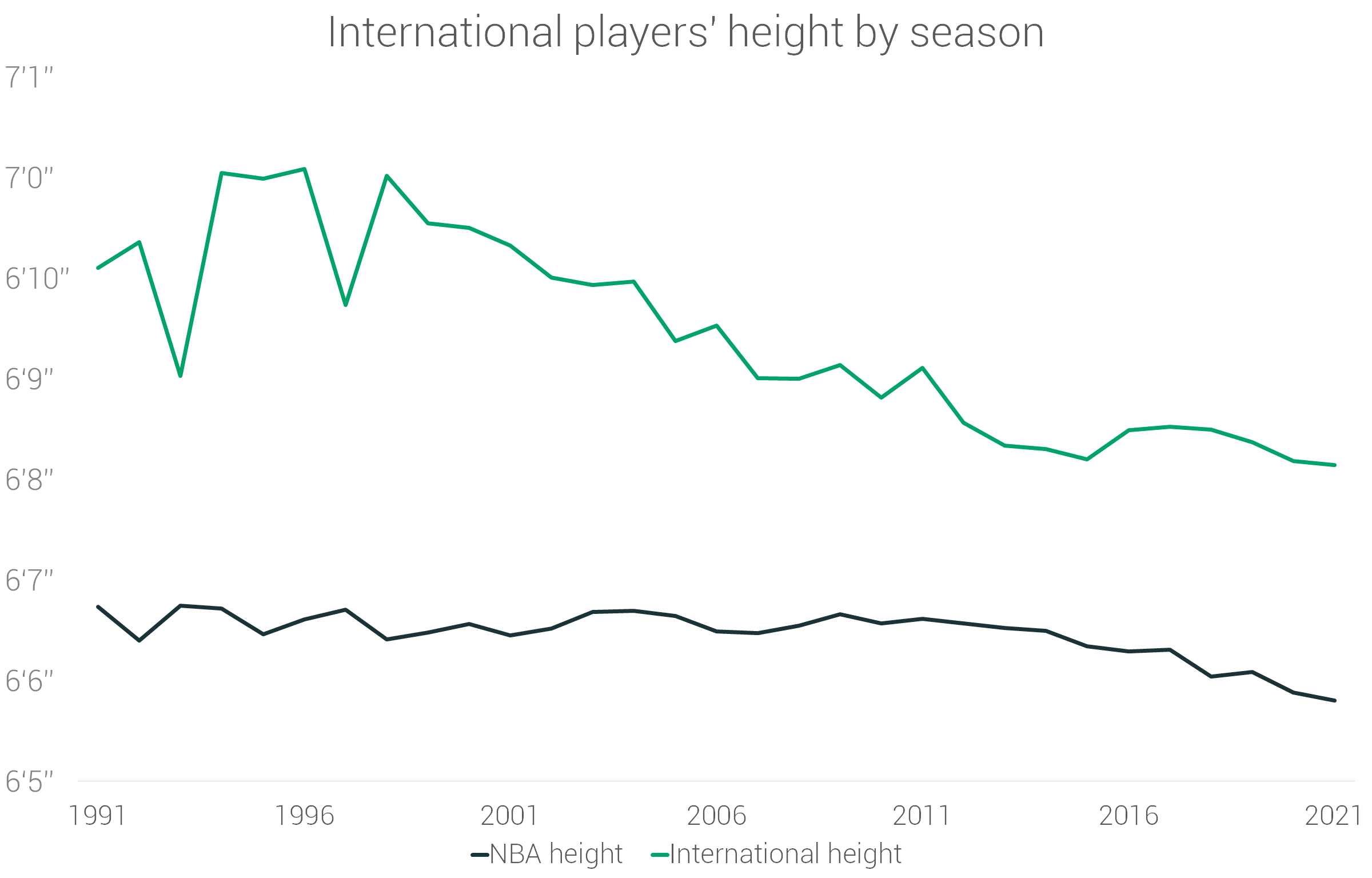
Breaking down by position, international players evolve along with the league’s tendencies - big-men are getting shorter, point guards are getting taller.

International centres recorded the highest share among NBA centres in the history of the league - in the 2019/20 season, 46% of all NBA centres come from overseas. In 2021 this share dropped to 30%, signalling that the USA centres are starting to adapt to the modern requirements of the game.

Similarly, 46% of NBA players taller than 6’9’’ are international players, and foreign 7-footers are accounting for 53% of league total. This data clearly shows that international big-men are still one of the most valuable assets from NBA teams.
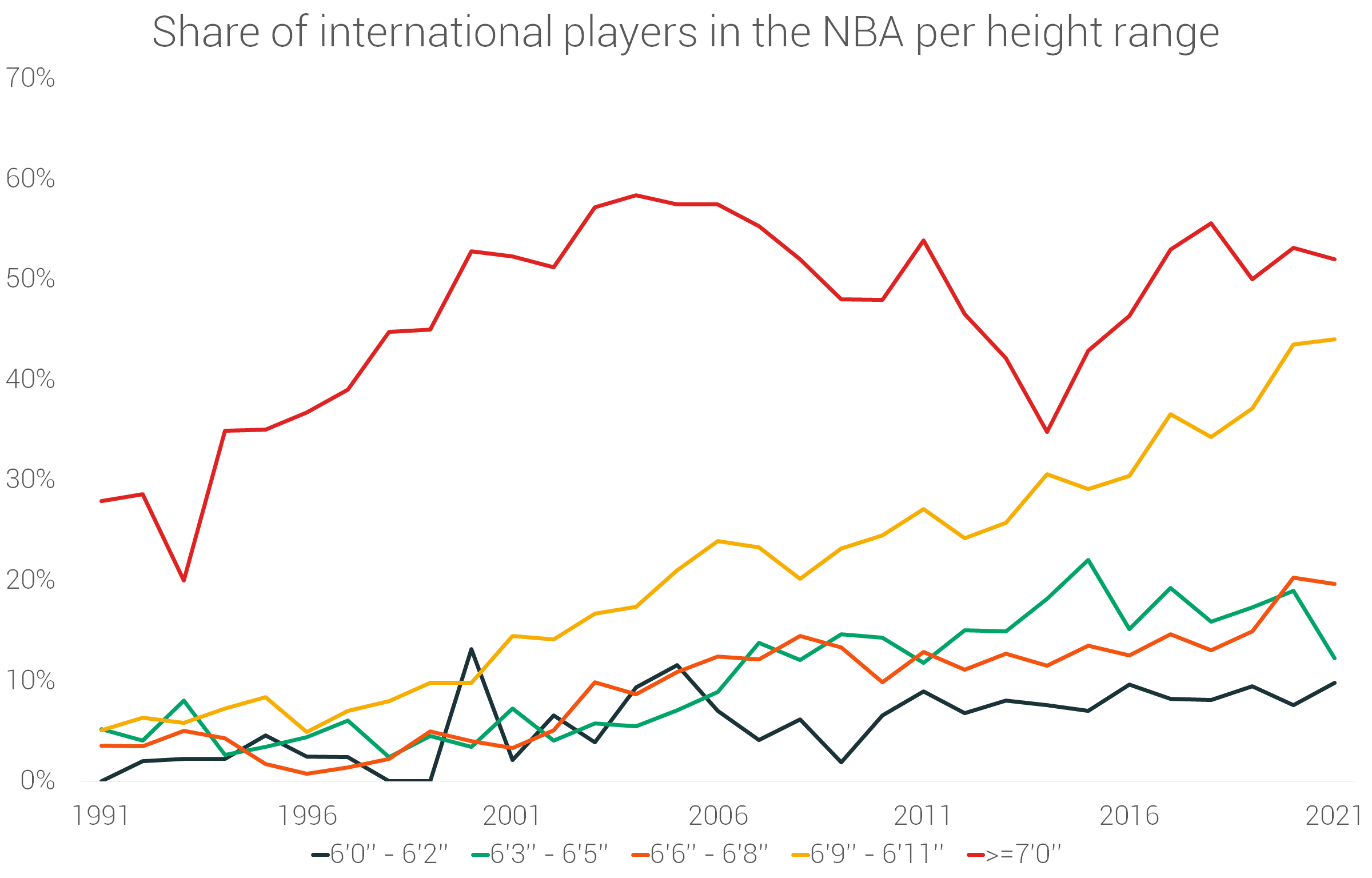
Over the years, big men coming from abroad, particularly from Europe, have proved to be more skillful with the ball in their hands. They’re educated to play a team basketball, share the ball and learn to read the game.
This is visible on the charts – since the new millennia, when the centers slowly but surely started getting more involved in the flow of the game, by setting pick&rolls and “migrating” outside of the paint, they needed to develop a new skill set, one that the European centers already possessed. In some way, it was the international big men who made the small-ball revolution possible.
6. Tables and data
| Season | Average NBA height |
| 1947 | 6'2.13'' |
| 1948 | 6'2.51'' |
| 1949 | 6'3.20'' |
| 1950 | 6'3.64'' |
| 1951 | 6'4.12'' |
| 1952 | 6'4.16'' |
| 1953 | 6'3.72'' |
| 1954 | 6'4.15'' |
| 1955 | 6'4.34'' |
| 1956 | 6'4.97'' |
| 1957 | 6'4.98'' |
| 1958 | 6'5.24'' |
| 1959 | 6'4.94'' |
| 1960 | 6'5.16'' |
| 1961 | 6'5.32'' |
| 1962 | 6'5.12'' |
| 1963 | 6'5.53'' |
| 1964 | 6'5.49'' |
| 1965 | 6'5.62'' |
| 1966 | 6'5.42'' |
| 1967 | 6'5.71'' |
| 1968 | 6'5.57'' |
| 1969 | 6'5.67'' |
| 1970 | 6'5.68'' |
| 1971 | 6'5.74'' |
| 1972 | 6'5.80'' |
| 1973 | 6'5.88'' |
| 1974 | 6'5.83'' |
| 1975 | 6'5.93'' |
| 1976 | 6'6.11'' |
| 1977 | 6'6.05'' |
| 1978 | 6'6.08'' |
| 1979 | 6'6.18'' |
| 1980 | 6'6.33'' |
| 1981 | 6'6.38'' |
| 1982 | 6'6.57'' |
| 1983 | 6'6.81'' |
| 1984 | 6'6.76'' |
| 1985 | 6'6.82'' |
| 1986 | 6'7.03'' |
| 1987 | 6'7.04'' |
| 1988 | 6'7.02'' |
| 1989 | 6'6.93'' |
| 1990 | 6'6.81'' |
| 1991 | 6'6.95'' |
| 1992 | 6'6.65'' |
| 1993 | 6'6.90'' |
| 1994 | 6'7.05'' |
| 1995 | 6'6.78'' |
| 1996 | 6'6.90'' |
| 1997 | 6'6.94'' |
| 1998 | 6'6.73'' |
| 1999 | 6'6.85'' |
| 2000 | 6'6.93'' |
| 2001 | 6'6.90'' |
| 2002 | 6'6.93'' |
| 2003 | 6'7.17'' |
| 2004 | 6'7.20'' |
| 2005 | 6'7.13'' |
| 2006 | 6'7.05'' |
| 2007 | 6'6.94'' |
| 2008 | 6'6.99'' |
| 2009 | 6'7.12'' |
| 2010 | 6'6.98'' |
| 2011 | 6'7.12'' |
| 2012 | 6'6.94'' |
| 2013 | 6'6.86'' |
| 2014 | 6'6.84'' |
| 2015 | 6'6.72'' |
| 2016 | 6'6.73'' |
| 2017 | 6'6.84'' |
| 2018 | 6'6.55'' |
| 2019 | 6'6.58'' |
| 2020 | 6'6.45'' |
| 2021 | 6'6.33'' |
| Season | PG | SG | SF | PF | C |
| 1947 | 6'1.1'' | 6'1.3'' | 6'2.9'' | 6'5.2'' | 6'7.6'' |
| 1948 | 6'1.1'' | 6'1.5'' | 6'3.3'' | 6'5.6'' | 6'6.8'' |
| 1949 | 6'0.2'' | 6'1.2'' | 6'3.1'' | 6'5.6'' | 6'8.2'' |
| 1950 | 6'0.1'' | 6'1.8'' | 6'3.3'' | 6'6.2'' | 6'8.5'' |
| 1951 | 6'0.2'' | 6'1.8'' | 6'3.8'' | 6'6.4'' | 6'9.1'' |
| 1952 | 6'0.6'' | 6'1.4'' | 6'4.4'' | 6'6.1'' | 6'8.5'' |
| 1953 | 6'0.0'' | 6'1.7'' | 6'4.4'' | 6'6.9'' | 6'8.5'' |
| 1954 | 6'0.1'' | 6'1.7'' | 6'4.9'' | 6'6.5'' | 6'8.9'' |
| 1955 | 6'1.3'' | 6'2.1'' | 6'4.5'' | 6'6.8'' | 6'8.8'' |
| 1956 | 6'1.1'' | 6'3.0'' | 6'4.9'' | 6'7.1'' | 6'8.9'' |
| 1957 | 6'1.3'' | 6'2.7'' | 6'5.1'' | 6'7.1'' | 6'9.0'' |
| 1958 | 6'2.0'' | 6'3.0'' | 6'4.9'' | 6'7.5'' | 6'9.1'' |
| 1959 | 6'1.8'' | 6'3.1'' | 6'5.2'' | 6'7.4'' | 6'9.1'' |
| 1960 | 6'1.7'' | 6'3.1'' | 6'5.1'' | 6'7.4'' | 6'9'' |
| 1961 | 6'1.6'' | 6'3.4'' | 6'5.7'' | 6'7.2'' | 6'9'' |
| 1962 | 6'1.6'' | 6'3.6'' | 6'5.7'' | 6'7.2'' | 6'10'' |
| 1963 | 6'1.4'' | 6'3.3'' | 6'5.9'' | 6'7.2'' | 6'9'' |
| 1964 | 6'1.7'' | 6'3.6'' | 6'6.0'' | 6'7.4'' | 6'9'' |
| 1965 | 6'1.8'' | 6'3.5'' | 6'5.7'' | 6'7.7'' | 6'10'' |
| 1966 | 6'1.3'' | 6'3.6'' | 6'6.0'' | 6'7.1'' | 6'9'' |
| 1967 | 6'1.5'' | 6'3.6'' | 6'5.7'' | 6'7.4'' | 6'9'' |
| 1968 | 6'1.9'' | 6'3.4'' | 6'5.8'' | 6'7.4'' | 6'9'' |
| 1969 | 6'1.4'' | 6'3.3'' | 6'5.8'' | 6'7.6'' | 6'9'' |
| 1970 | 6'1.9'' | 6'3.3'' | 6'5.8'' | 6'7.4'' | 6'10'' |
| 1971 | 6'1.4'' | 6'3.4'' | 6'6.2'' | 6'7.5'' | 6'9'' |
| 1972 | 6'1.7'' | 6'3.4'' | 6'5.9'' | 6'7.7'' | 6'10'' |
| 1973 | 6'1.9'' | 6'3.3'' | 6'6.0'' | 6'7.6'' | 6'10'' |
| 1974 | 6'1.6'' | 6'3.4'' | 6'6.1'' | 6'8.0'' | 6'10'' |
| 1975 | 6'1.8'' | 6'3.5'' | 6'6.2'' | 6'7.9'' | 6'10'' |
| 1976 | 6'1.8'' | 6'3.4'' | 6'6.4'' | 6'8.1'' | 6'10'' |
| 1977 | 6'1.7'' | 6'3.5'' | 6'6.4'' | 6'8.2'' | 6'10'' |
| 1978 | 6'1.7'' | 6'3.5'' | 6'6.8'' | 6'8.4'' | 6'10'' |
| 1979 | 6'1.8'' | 6'3.9'' | 6'6.6'' | 6'8.3'' | 6'10'' |
| 1980 | 6'1.9'' | 6'3.9'' | 6'6.7'' | 6'8.6'' | 6'10'' |
| 1981 | 6'1.7'' | 6'4.3'' | 6'6.9'' | 6'8.6'' | 6'10'' |
| 1982 | 6'1.6'' | 6'4.2'' | 6'6.9'' | 6'8.7'' | 6'11'' |
| 1983 | 6'2.0'' | 6'4.0'' | 6'6.9'' | 6'8.8'' | 6'10'' |
| 1984 | 6'2.2'' | 6'4.4'' | 6'7.0'' | 6'8.9'' | 6'11'' |
| 1985 | 6'2.2'' | 6'4.3'' | 6'6.9'' | 6'9.0'' | 6'11'' |
| 1986 | 6'2.3'' | 6'4.4'' | 6'7.1'' | 6'8.9'' | 6'11'' |
| 1987 | 6'2.4'' | 6'4.6'' | 6'7.0'' | 6'9.2'' | 6'11'' |
| 1988 | 6'1.8'' | 6'4.7'' | 6'7.3'' | 6'9.2'' | 6'11'' |
| 1989 | 6'2.0'' | 6'4.4'' | 6'7.1'' | 6'9.0'' | 6'11'' |
| 1990 | 6'1.4'' | 6'4.7'' | 6'7.1'' | 6'9.1'' | 6'11'' |
| 1991 | 6'1.7'' | 6'4.7'' | 6'6.9'' | 6'9.1'' | 6'11'' |
| 1992 | 6'1.3'' | 6'4.6'' | 6'7.0'' | 6'9.1'' | 6'11'' |
| 1993 | 6'1.1'' | 6'4.7'' | 6'7.1'' | 6'9.0'' | 6'11'' |
| 1994 | 6'1.2'' | 6'4.7'' | 6'7.4'' | 6'9.0'' | 6'11'' |
| 1995 | 6'1.4'' | 6'4.9'' | 6'7.4'' | 6'9.1'' | 6'11'' |
| 1996 | 6'1.1'' | 6'5.0'' | 6'7.3'' | 6'9.0'' | 6'11'' |
| 1997 | 6'1.6'' | 6'4.8'' | 6'7.3'' | 6'9.1'' | 6'11'' |
| 1998 | 6'1.2'' | 6'4.8'' | 6'7.4'' | 6'9.0'' | 6'11'' |
| 1999 | 6'1.4'' | 6'4.9'' | 6'7.4'' | 6'9.1'' | 6'11'' |
| 2000 | 6'1.7'' | 6'5.0'' | 6'7.6'' | 6'9.0'' | 6'11'' |
| 2001 | 6'1.9'' | 6'5.0'' | 6'7.7'' | 6'9.1'' | 6'11'' |
| 2002 | 6'1.6'' | 6'4.8'' | 6'7.7'' | 6'9.1'' | 6'11'' |
| 2003 | 6'2.0'' | 6'5.2'' | 6'7.9'' | 6'9.3'' | 6'11'' |
| 2004 | 6'1.9'' | 6'4.9'' | 6'7.6'' | 6'9.3'' | 6'11'' |
| 2005 | 6'1.8'' | 6'5.1'' | 6'7.6'' | 6'9.4'' | 6'11'' |
| 2006 | 6'1.9'' | 6'5.0'' | 6'7.7'' | 6'9.3'' | 6'11'' |
| 2007 | 6'1.6'' | 6'5.1'' | 6'7.3'' | 6'9.1'' | 6'11'' |
| 2008 | 6'1.7'' | 6'5.1'' | 6'7.4'' | 6'9.0'' | 6'11'' |
| 2009 | 6'2.0'' | 6'5.3'' | 6'7.5'' | 6'9.2'' | 6'11'' |
| 2010 | 6'1.9'' | 6'5.3'' | 6'7.5'' | 6'9.1'' | 6'11'' |
| 2011 | 6'1.8'' | 6'5.3'' | 6'7.7'' | 6'9.2'' | 6'11'' |
| 2012 | 6'1.7'' | 6'5.1'' | 6'7.4'' | 6'9.2'' | 6'10'' |
| 2013 | 6'1.9'' | 6'4.6'' | 6'7.5'' | 6'9.2'' | 6'10'' |
| 2014 | 6'2.0'' | 6'4.6'' | 6'7.5'' | 6'9.2'' | 6'10'' |
| 2015 | 6'1.9'' | 6'4.9'' | 6'7.7'' | 6'9.2'' | 6'10'' |
| 2016 | 6'2.2'' | 6'4.7'' | 6'7.1'' | 6'9.1'' | 6'10'' |
| 2017 | 6'2.1'' | 6'4.9'' | 6'7.1'' | 6'9.1'' | 6'11'' |
| 2018 | 6'2.2'' | 6'4.8'' | 6'7.1'' | 6'8.9'' | 6'10'' |
| 2019 | 6'2.5'' | 6'4.7'' | 6'7.0'' | 6'8.9'' | 6'10'' |
| 2020 | 6'2.4'' | 6'4.5'' | 6'6.9'' | 6'8.4'' | 6'10'' |
| 2021 | 6'2.4'' | 6'4.3'' | 6'6.6'' | 6'8.3'' | 6'10'' |
| Season | Average weight in the NBA |
| 1947 | 186 |
| 1948 | 187 |
| 1949 | 191 |
| 1950 | |
| 1951 | |
| 1952 | 197 |
| 1953 | 195 |
| 1954 | 196 |
| 1955 | 195 |
| 1956 | 200 |
| 1957 | 201 |
| 1958 | 201 |
| 1959 | 200 |
| 1960 | 202 |
| 1961 | 203 |
| 1962 | 202 |
| 1963 | 204 |
| 1964 | 205 |
| 1965 | 206 |
| 1966 | 205 |
| 1967 | 206 |
| 1968 | 205 |
| 1969 | 206 |
| 1970 | 205 |
| 1971 | 204 |
| 1972 | 205 |
| 1973 | 205 |
| 1974 | 203 |
| 1975 | 203 |
| 1976 | 204 |
| 1977 | 203 |
| 1978 | 203 |
| 1979 | 203 |
| 1980 | 204 |
| 1981 | 204 |
| 1982 | 204 |
| 1983 | 206 |
| 1984 | 206 |
| 1985 | 207 |
| 1986 | 208 |
| 1987 | 208 |
| 1988 | 208 |
| 1989 | 209 |
| 1990 | 208 |
| 1991 | 210 |
| 1992 | 209 |
| 1993 | 212 |
| 1994 | 213 |
| 1995 | 212 |
| 1996 | 214 |
| 1997 | 215 |
| 1998 | 214 |
| 1999 | 216 |
| 2000 | 216 |
| 2001 | 217 |
| 2002 | 219 |
| 2003 | 220 |
| 2004 | 220 |
| 2005 | 221 |
| 2006 | 221 |
| 2007 | 221 |
| 2008 | 220 |
| 2009 | 221 |
| 2010 | 221 |
| 2011 | 223 |
| 2012 | 222 |
| 2013 | 222 |
| 2014 | 222 |
| 2015 | 220 |
| 2016 | 221 |
| 2017 | 220 |
| 2018 | 217 |
| 2019 | 217 |
| 2020 | 216 |
| 2021 | 217 |
| Season | PG | SG | SF | PF | C |
| 1947 | 174 | 178 | 188 | 196 | 223 |
| 1948 | 169 | 179 | 193 | 192 | 221 |
| 1949 | 173 | 179 | 191 | 201 | 222 |
| 1950 | |||||
| 1951 | |||||
| 1952 | 175 | 183 | 201 | 208 | 218 |
| 1953 | 176 | 184 | 202 | 211 | 217 |
| 1954 | 179 | 180 | 199 | 208 | 222 |
| 1955 | 180 | 184 | 194 | 211 | 215 |
| 1956 | 181 | 187 | 202 | 209 | 219 |
| 1957 | 180 | 190 | 206 | 211 | 216 |
| 1958 | 184 | 188 | 204 | 211 | 218 |
| 1959 | 185 | 190 | 205 | 207 | 220 |
| 1960 | 182 | 189 | 205 | 209 | 227 |
| 1961 | 183 | 189 | 209 | 215 | 226 |
| 1962 | 182 | 192 | 210 | 213 | 226 |
| 1963 | 182 | 190 | 206 | 214 | 226 |
| 1964 | 184 | 192 | 209 | 217 | 229 |
| 1965 | 185 | 191 | 211 | 215 | 230 |
| 1966 | 183 | 192 | 210 | 215 | 229 |
| 1967 | 182 | 189 | 208 | 217 | 229 |
| 1968 | 184 | 192 | 208 | 217 | 226 |
| 1969 | 182 | 192 | 208 | 216 | 229 |
| 1970 | 181 | 191 | 209 | 216 | 229 |
| 1971 | 180 | 189 | 207 | 216 | 227 |
| 1972 | 180 | 188 | 206 | 218 | 230 |
| 1973 | 180 | 188 | 207 | 216 | 228 |
| 1974 | 180 | 188 | 206 | 215 | 228 |
| 1975 | 179 | 188 | 204 | 216 | 225 |
| 1976 | 180 | 188 | 205 | 218 | 225 |
| 1977 | 180 | 187 | 206 | 217 | 225 |
| 1978 | 180 | 188 | 207 | 217 | 226 |
| 1979 | 179 | 189 | 205 | 216 | 228 |
| 1980 | 179 | 188 | 205 | 219 | 227 |
| 1981 | 177 | 191 | 205 | 217 | 230 |
| 1982 | 176 | 190 | 205 | 218 | 231 |
| 1983 | 177 | 189 | 205 | 219 | 231 |
| 1984 | 178 | 192 | 206 | 220 | 233 |
| 1985 | 179 | 190 | 208 | 220 | 232 |
| 1986 | 179 | 190 | 209 | 221 | 235 |
| 1987 | 179 | 191 | 208 | 223 | 238 |
| 1988 | 177 | 192 | 209 | 223 | 239 |
| 1989 | 177 | 191 | 209 | 224 | 239 |
| 1990 | 175 | 193 | 210 | 225 | 237 |
| 1991 | 176 | 194 | 209 | 225 | 239 |
| 1992 | 175 | 194 | 212 | 224 | 242 |
| 1993 | 177 | 195 | 212 | 227 | 243 |
| 1994 | 178 | 195 | 213 | 227 | 244 |
| 1995 | 178 | 195 | 215 | 228 | 244 |
| 1996 | 177 | 197 | 217 | 229 | 247 |
| 1997 | 181 | 198 | 216 | 231 | 248 |
| 1998 | 180 | 197 | 217 | 232 | 246 |
| 1999 | 181 | 201 | 217 | 232 | 246 |
| 2000 | 183 | 199 | 219 | 235 | 246 |
| 2001 | 184 | 200 | 219 | 234 | 248 |
| 2002 | 184 | 201 | 220 | 238 | 249 |
| 2003 | 186 | 204 | 222 | 239 | 247 |
| 2004 | 186 | 202 | 219 | 238 | 248 |
| 2005 | 186 | 204 | 219 | 239 | 251 |
| 2006 | 187 | 204 | 220 | 240 | 253 |
| 2007 | 186 | 204 | 218 | 237 | 253 |
| 2008 | 186 | 206 | 218 | 234 | 252 |
| 2009 | 187 | 207 | 219 | 238 | 251 |
| 2010 | 187 | 207 | 220 | 240 | 251 |
| 2011 | 189 | 209 | 222 | 238 | 253 |
| 2012 | 189 | 208 | 221 | 239 | 252 |
| 2013 | 190 | 205 | 221 | 237 | 255 |
| 2014 | 188 | 205 | 221 | 240 | 255 |
| 2015 | 189 | 206 | 220 | 240 | 255 |
| 2016 | 189 | 205 | 220 | 239 | 253 |
| 2017 | 189 | 205 | 220 | 236 | 251 |
| 2018 | 189 | 204 | 219 | 234 | 248 |
| 2019 | 192 | 205 | 215 | 232 | 248 |
| 2020 | 192 | 202 | 215 | 230 | 246 |
| 2021 | 192 | 202 | 214 | 230 | 248 |
| Season | Average height of NBA rookies by season |
| 1947 | 6'2.1'' |
| 1948 | 6'2.8'' |
| 1949 | 6'3.1'' |
| 1950 | 6'3.4'' |
| 1951 | 6'4.3'' |
| 1952 | 6'3.8'' |
| 1953 | 6'3.4'' |
| 1954 | 6'4.4'' |
| 1955 | 6'4.0'' |
| 1956 | 6'4.9'' |
| 1957 | 6'5.3'' |
| 1958 | 6'4.6'' |
| 1959 | 6'4.8'' |
| 1960 | 6'5.4'' |
| 1961 | 6'5.1'' |
| 1962 | 6'4.4'' |
| 1963 | 6'5.6'' |
| 1964 | 6'5.1'' |
| 1965 | 6'5.4'' |
| 1966 | 6'5.3'' |
| 1967 | 6'5.8'' |
| 1968 | 6'5.4'' |
| 1969 | 6'6.0'' |
| 1970 | 6'5.4'' |
| 1971 | 6'5.9'' |
| 1972 | 6'6.1'' |
| 1973 | 6'5.6'' |
| 1974 | 6'5.9'' |
| 1975 | 6'5.6'' |
| 1976 | 6'6.3'' |
| 1977 | 6'5.7'' |
| 1978 | 6'5.7'' |
| 1979 | 6'5.8'' |
| 1980 | 6'6.4'' |
| 1981 | 6'6.3'' |
| 1982 | 6'6.8'' |
| 1983 | 6'7.2'' |
| 1984 | 6'7.1'' |
| 1985 | 6'7.2'' |
| 1986 | 6'7.5'' |
| 1987 | 6'7.1'' |
| 1988 | 6'6.4'' |
| 1989 | 6'6.5'' |
| 1990 | 6'6.1'' |
| 1991 | 6'7.2'' |
| 1992 | 6'5.9'' |
| 1993 | 6'6.5'' |
| 1994 | 6'7.4'' |
| 1995 | 6'6.5'' |
| 1996 | 6'6.8'' |
| 1997 | 6'6.8'' |
| 1998 | 6'6.7'' |
| 1999 | 6'6.9'' |
| 2000 | 6'6.5'' |
| 2001 | 6'7.8'' |
| 2002 | 6'7.4'' |
| 2003 | 6'7.2'' |
| 2004 | 6'7.0'' |
| 2005 | 6'6.7'' |
| 2006 | 6'6.5'' |
| 2007 | 6'6.8'' |
| 2008 | 6'7.4'' |
| 2009 | 6'7.2'' |
| 2010 | 6'5.6'' |
| 2011 | 6'7.4'' |
| 2012 | 6'6.0'' |
| 2013 | 6'6.8'' |
| 2014 | 6'6.6'' |
| 2015 | 6'6.6'' |
| 2016 | 6'7.2'' |
| 2017 | 6'6.5'' |
| 2018 | 6'6.3'' |
| 2019 | 6'6.1'' |
| 2020 | 6'6.1'' |
| 2021 | 6'5.8'' |
| Season | PG | SG | SF | PF | C |
| 1947 | 6'1.1'' | 6'1.3'' | 6'2.9'' | 6'5.2'' | 6'7.6'' |
| 1948 | 6'0.8'' | 6'5.0'' | 6'3.2'' | 6'5.7'' | 6'6.0'' |
| 1949 | 6'0.4'' | 6'0.9'' | 6'3.0'' | 6'5.8'' | 6'9.0'' |
| 1950 | 6'0.1'' | 6'1.8'' | 6'3.6'' | 6'5.9'' | 6'9.3'' |
| 1951 | 6'1.5'' | 6'2.0'' | 6'4.4'' | 6'6.3'' | 6'9.0'' |
| 1952 | 6'1.2'' | 6'0.3'' | 6'4.1'' | 6'8.0'' | 6'7.7'' |
| 1953 | 6'0.0'' | 6'1.8'' | 6'3.7'' | 6'7.8'' | 6'7.5'' |
| 1954 | 6'0.5'' | 6'2.7'' | 6'5.0'' | 6'6.8'' | 6'8.7'' |
| 1955 | 6'2.2'' | 6'3.0'' | 6'4.4'' | 6'7.3'' | 6'8.7'' |
| 1956 | 6'1.7'' | 6'3.4'' | 6'5.4'' | 6'6.8'' | 6'8.3'' |
| 1957 | 6'1.8'' | 6'3.0'' | 6'5.8'' | 6'7.3'' | 6'8.3'' |
| 1958 | 6'2.8'' | 6'3.5'' | 6'4.7'' | 6'7.5'' | 6'8.0'' |
| 1959 | 6'1.0'' | 6'2.0'' | 6'5.9'' | 6'6.3'' | 6'9.0'' |
| 1960 | 6'1.8'' | 6'3.5'' | 6'4.2'' | 6'7.0'' | 6'9'' |
| 1961 | 6'1.0'' | 6'3.0'' | 6'6.1'' | 6'7.0'' | 7'0'' |
| 1962 | 6'0.8'' | 6'3.7'' | 6'6.3'' | 6'7.3'' | 6'9'' |
| 1963 | 6'2.0'' | 6'2.7'' | 6'5.4'' | 6'7.2'' | 6'9'' |
| 1964 | 6'2.4'' | 6'4.1'' | 6'5.0'' | 6'8.3'' | 6'10'' |
| 1965 | 6'2.0'' | 6'2.8'' | 6'5.4'' | 6'8.0'' | 6'10'' |
| 1966 | 6'0.3'' | 6'4.2'' | 6'6.7'' | 6'6.0'' | 6'8'' |
| 1967 | 6'2.0'' | 6'3.6'' | 6'5.6'' | 6'7.8'' | 6'9'' |
| 1968 | 6'2.0'' | 6'2.9'' | 6'5.9'' | 6'7.4'' | 6'9'' |
| 1969 | 6'1.4'' | 6'3.3'' | 6'5.3'' | 6'7.7'' | 6'9'' |
| 1970 | 6'2.6'' | 6'2.6'' | 6'5.9'' | 6'7.5'' | 6'10'' |
| 1971 | 6'0.9'' | 6'3.6'' | 6'6.8'' | 6'7.7'' | 6'9'' |
| 1972 | 6'2.8'' | 6'3.1'' | 6'6.0'' | 6'7.7'' | 6'11'' |
| 1973 | 6'1.6'' | 6'3.2'' | 6'6.1'' | 6'8.1'' | 6'10'' |
| 1974 | 6'1.6'' | 6'2.8'' | 6'6.1'' | 6'8.3'' | 6'10'' |
| 1975 | 6'1.3'' | 6'2.7'' | 6'6.7'' | 6'8.4'' | 6'10'' |
| 1976 | 6'1.3'' | 6'3.2'' | 6'6.6'' | 6'8.5'' | 6'10'' |
| 1977 | 6'2.3'' | 6'3.6'' | 6'6.5'' | 6'9.0'' | 6'10'' |
| 1978 | 6'0.9'' | 6'3.8'' | 6'6.9'' | 6'8.3'' | 6'11'' |
| 1979 | 6'1.5'' | 6'4.7'' | 6'6.4'' | 6'7.3'' | 6'10'' |
| 1980 | 6'2.5'' | 6'3.8'' | 6'6.8'' | 6'8.9'' | 6'10'' |
| 1981 | 6'1.7'' | 6'4.5'' | 6'6.8'' | 6'8.8'' | 6'11'' |
| 1982 | 6'1.4'' | 6'4.8'' | 6'6.6'' | 6'8.8'' | 6'11'' |
| 1983 | 6'3.2'' | 6'4.2'' | 6'7.4'' | 6'8.8'' | 6'11'' |
| 1984 | 6'2.5'' | 6'4.4'' | 6'7.7'' | 6'9.5'' | 6'11'' |
| 1985 | 6'2.4'' | 6'4.0'' | 6'7.1'' | 6'9.2'' | 6'11'' |
| 1986 | 6'1.0'' | 6'4.4'' | 6'7.5'' | 6'8.6'' | 7'0.'' |
| 1987 | 6'2.3'' | 6'5.1'' | 6'7.1'' | 6'9.4'' | 6'10'' |
| 1988 | 6'0.9'' | 6'5.2'' | 6'7.6'' | 6'9.6'' | 6'11'' |
| 1989 | 6'1.9'' | 6'4.4'' | 6'7.3'' | 6'8.7'' | 6'11'' |
| 1990 | 6'0.8'' | 6'4.8'' | 6'7.4'' | 6'8.5'' | 6'10'' |
| 1991 | 6'2.0'' | 6'4.3'' | 6'6.7'' | 6'9.3'' | 6'11'' |
| 1992 | 6'0.6'' | 6'4.6'' | 6'6.7'' | 6'9.0'' | 6'11'' |
| 1993 | 6'0.5'' | 6'5.0'' | 6'6.9'' | 6'8.9'' | 6'10'' |
| 1994 | 6'1.6'' | 6'5.1'' | 6'7.3'' | 6'8.6'' | 6'11'' |
| 1995 | 6'2.0'' | 6'5.1'' | 6'7.7'' | 6'8.6'' | 6'11'' |
| 1996 | 6'0.9'' | 6'4.9'' | 6'7.4'' | 6'8.9'' | 6'11'' |
| 1997 | 6'1.8'' | 6'3.8'' | 6'7.0'' | 6'8.9'' | 6'11'' |
| 1998 | 6'1.8'' | 6'4.7'' | 6'7.5'' | 6'9.0'' | 6'11'' |
| 1999 | 6'1.1'' | 6'4.5'' | 6'7.5'' | 6'9.7'' | 6'11'' |
| 2000 | 6'2.3'' | 6'4.8'' | 6'7.7'' | 6'8.6'' | 6'11'' |
| 2001 | 6'2.5'' | 6'5.7'' | 6'8.5'' | 6'9.0'' | 6'11'' |
| 2002 | 6'1.3'' | 6'4.6'' | 6'8.1'' | 6'9.8'' | 6'11'' |
| 2003 | 6'2.8'' | 6'5.0'' | 6'8.0'' | 6'9.5'' | 6'11'' |
| 2004 | 6'2.7'' | 6'5.5'' | 6'7.1'' | 6'8.5'' | 6'11'' |
| 2005 | 6'1.3'' | 6'5.5'' | 6'7.5'' | 6'9.7'' | 6'11'' |
| 2006 | 6'1.9'' | 6'4.7'' | 6'7.9'' | 6'9.0'' | 6'11'' |
| 2007 | 6'1.6'' | 6'5.0'' | 6'7.2'' | 6'8.8'' | 6'10'' |
| 2008 | 6'2.2'' | 6'4.9'' | 6'7.9'' | 6'9.1'' | 6'11'' |
| 2009 | 6'2.2'' | 6'5.7'' | 6'7.7'' | 6'9.5'' | 6'11'' |
| 2010 | 6'2.0'' | 6'4.7'' | 6'7.3'' | 6'9.3'' | 6'11'' |
| 2011 | 6'1.9'' | 6'5.7'' | 6'7.1'' | 6'8.6'' | 6'11'' |
| 2012 | 6'1.8'' | 6'5.4'' | 6'7.3'' | 6'9.1'' | 6'10'' |
| 2013 | 6'2.0'' | 6'4.6'' | 6'7.3'' | 6'9.2'' | 6'10'' |
| 2014 | 6'2.1'' | 6'4.7'' | 6'7.3'' | 6'9.1'' | 6'11'' |
| 2015 | 6'2.0'' | 6'5.1'' | 6'7.9'' | 6'9.3'' | 6'11'' |
| 2016 | 6'2.6'' | 6'5.2'' | 6'6.8'' | 6'9.2'' | 7'0.'' |
| 2017 | 6'1.8'' | 6'5.1'' | 6'6.9'' | 6'9.3'' | 6'11'' |
| 2018 | 6'3.0'' | 6'4.8'' | 6'7.0'' | 6'9.2'' | 6'10'' |
| 2019 | 6'2.3'' | 6'4.6'' | 6'6.8'' | 6'8.9'' | 6'10'' |
| 2020 | 6'1.5'' | 6'4.4'' | 6'6.7'' | 6'8.3'' | 6'11'' |
| 2021 | 6'2.6'' | 6'4.0'' | 6'6.2'' | 6'8.8'' | 6'9'' |
| Season | Average NBA height | Average International height |
| 1981 | 6'6'' | 6'9'' |
| 1982 | 6'7'' | 6'9'' |
| 1983 | 6'7'' | 6'9'' |
| 1984 | 6'7'' | 6'8'' |
| 1985 | 6'7'' | 6'8'' |
| 1986 | 6'7'' | 6'11'' |
| 1987 | 6'7'' | 6'10'' |
| 1988 | 6'7'' | 6'11'' |
| 1989 | 6'7'' | 6'11'' |
| 1990 | 6'7'' | 6'10'' |
| 1991 | 6'7'' | 6'10'' |
| 1992 | 6'6'' | 6'10'' |
| 1993 | 6'7'' | 6'9'' |
| 1994 | 6'7'' | 6'11'' |
| 1995 | 6'6'' | 6'11'' |
| 1996 | 6'7'' | 6'11'' |
| 1997 | 6'7'' | 6'9'' |
| 1998 | 6'6'' | 6'11'' |
| 1999 | 6'6'' | 6'10'' |
| 2000 | 6'7'' | 6'10'' |
| 2001 | 6'6'' | 6'10'' |
| 2002 | 6'7'' | 6'10'' |
| 2003 | 6'7'' | 6'9'' |
| 2004 | 6'7'' | 6'9'' |
| 2005 | 6'7'' | 6'9'' |
| 2006 | 6'6'' | 6'9'' |
| 2007 | 6'6'' | 6'9'' |
| 2008 | 6'7'' | 6'9'' |
| 2009 | 6'7'' | 6'9'' |
| 2010 | 6'7'' | 6'8'' |
| 2011 | 6'7'' | 6'9'' |
| 2012 | 6'7'' | 6'8'' |
| 2013 | 6'7'' | 6'8'' |
| 2014 | 6'6'' | 6'8'' |
| 2015 | 6'6'' | 6'8'' |
| 2016 | 6'6'' | 6'8'' |
| 2017 | 6'6'' | 6'8'' |
| 2018 | 6'6'' | 6'8'' |
| 2019 | 6'6'' | 6'8'' |
| 2020 | 6'6'' | 6'8'' |
| 2021 | 6'6'' | 6'8'' |
Important Notes
- Although the first NBA season was 1946/47, the results displayed in this research are starting from the 1951/52 season, due to the incomplete data for the previous seasons.
- The exceptions are 3-point shooting (introduced in 79/80), off/def rebounds, steals, and blocks (started recording from 73/74).
Height evolution vs. footwear evolution
Back in the "old days", when the game was played inside-out, big guys dominated the league. They were the first players to get their signature basketball shoes, starting with now-legendary Chuck Taylor's. The 80s brought a lot of changes to the game, following the arrival of Michael Jordan. Nike basketball shoe division saw in MJ what no other brand could see, and in 1985 the first Air Jordans were born. This was the first major shoe deal signed by an NBA guard, and it changed the shoe industry forever. The last big man to impact the shoe industry was Shaquille O'Neal and his famous Shaq Attack models.
Today, small guys are dominating the league. Steph Curry single-handedly changed the game, and Under Armour didn't want to miss that opportunity. It's the small-guy league now, and signature shoes are driven by stars like James Harden and Kyrie Irving.
Use of content
- Feel free to use any material from this page, as long as a reference is added to this original piece.
- Reach out to Dimitrije at dimitrije@runrepeat.com for any requests or questions about the graphics, text or print usage.
